Ronald.phillips
Shared posts
NASA Webb Telescope Spots Giant Galaxies From Not Long After Big Bang - CNET
Half-Life gets a Full Path/Ray Tracing Mod, available now for download
Modder ‘sultim_t’ has released a must-have mod for all Half-Life fans. As the title suggests, this mod brings real-time full path tracing to Valve’s classic first-person shooter. sultim_t is the man behind the Path Tracing mods for Doom, Serious Sam TFE and Quake. This is an incredible mod and below you can find a video that … Continue reading Half-Life gets a Full Path/Ray Tracing Mod, available now for download →
The post Half-Life gets a Full Path/Ray Tracing Mod, available now for download appeared first on DSOGaming.
"Sir" and "Ma'am" are so outdated. The correct thing to teach your children now is "Yes, Chef" [Amusing]
No Man’s Sky: Fractal Update Is Available Today
Hello, we’re excited to let you know that today we are releasing our first major update of 2023. We’re calling it Fractal (version 4.1).
The Fractal update introduces the chance to earn a stunning and exclusive new starship, the Utopia Speeder, which allows travellers to skim across planet surfaces at high velocity.
We’re also launching a new Expedition, Utopia, which challenges players to work together and rebuild an abandoned solar system for the mysterious Utopia Foundation. All is not as it seems, and an expedition-exclusive new crafting mechanic will require players to think about exploration, construction and survival in a whole new way. Other expedition rewards include the exclusive new Fearsome Visor helmet, a robotic drone companion, and much more.

Exploration-minded players also have a new tool-the brand new Wonders Catalogue. This shows off your most incredible discoveries, from tallest mountain to strangest creature. This detailed record of your journey not only allows you to easily compare records with fellow travellers, but gives explorers new goals as they set out to find and document the universe’s most unusual sights.
The options menu has also been totally reworked, introducing a raft of new accessibility features and giving players even more control over the way they play and experience the game. What’s more, these new system features and controls are joined by even more in-game quality of life changes and improvements.

2022 was a pretty packed year for No Man’s Sky with major free updates like Sentinel, Outlaws, Leviathan, Endurance, and Waypoint, plus a whole suite of expeditions. We’ve got an even bigger year planned for 2023, with Fractal marking just the starting point.
Thanks again so much for your continued support. It means a lot to us.


No Man's Sky
Hello Games
Seven Things to Know Before Playing the Wo Long: Fallen Dynasty Demo
Microsoft Flight Simulator Adds New Plane To Local Legend Series
Microsoft Flight Simulator: World Update XII Takes Us To New Zealand with Captivating Fidelity
The most interesting space trader is still one from 1998

Even after a decade marked by the abandonware crowd being proven right, there are old games that remain lost between the cracks of digital distribution. Instead of waxing lyrical about that though, I'm here today with good news: My favourite open world 3D spaceflight/trading sim Hardwar is back.
It's been back for over a year, in fact, via Zoom Platform, who've just made the interesting choice to publish it on Steam too, promising that their own store will remain resolutely DRM-free, and that this aims "to help fund additional signings and improvements for our DRM-Free preservation efforts". I'll brush aside analysing this strategy, because the immediate upshot is that, hopefully, Hardwar might finally get its due. In a better world, we'd already be playing its modern descendants.
Scientists Find Evidence of Brain Surgery on 3,000-Year-Old Skull - CNET
SFTP Port Forwarding: Enabling Suppressed Functionality

Introduction
The SSH protocol enables three major classes of remote server activities: a) command execution (including a login shell), b) network forwarding and manipulation, and c) file transfer.
The OpenSSH maintainers have determined that sftp and scp have no legitimate use for port forwarding (via the -L and -R options). A flag to explicitly disable these features is unconditionally passed to the child SSH executable during file transfers with these utilities.
There may be users with a legitimate need for these features. An obvious subset are penetration testers tasked to verify that this capability is explicitly disabled on public SFTP servers.
Below are two techniques to enable these suppressed features, by either modifying strings in the sftp binary itself, or by redirection through shells that are able to easily edit the command line. Depending upon the capabilities of the platform, either technique might be required to achieve this goal.
Suppression Details
To begin, it is important to locate running processes of interest. The shell function below will reveal PIDs that match a shell pattern (and note this is not a regex). This runs under Debian dash (and most other common shells) and relies on BSD options to ps:
pps () { local a= b= c= IFS=$'\r'; ps ax | while read -r a
do [ "$b" ] || c=1; for b; do case "$a" in *"$b"*) c=1;;
esac; done; [ "$c" ] && printf '%s\n' "$a" && c=; done; }
A conventional SFTP session is launched, in order to examine the processes associated with it:
$ id uid=1001(aturing) gid=1001(aturing) groups=1001(aturing)... $ sftp aturing@sftp.victimandum.com aturing@sftp.victimandum.com's password: Connected to sftp.victimandum.com. sftp>
We assume above that the local UNIX user has an account on the remote SFTP server of the same username.
Once the session is running, a local process search for the username reveals the child SSH process that is spawned by SFTP:
Christopher Reeve Thought Richard Pryor's Casting Was What Sunk Superman III
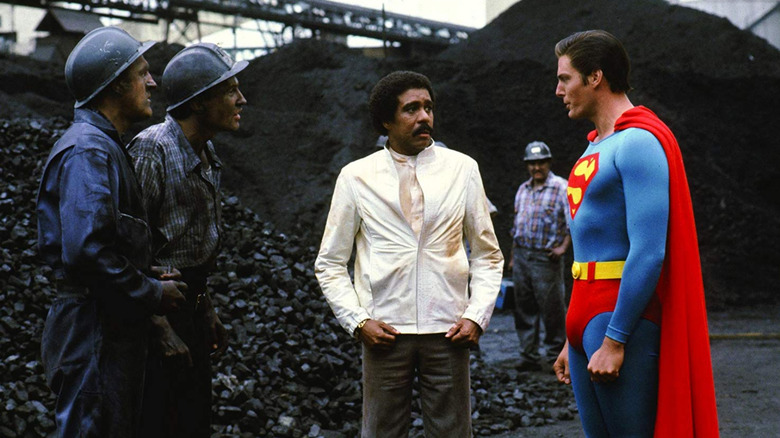
In many successful film franchises, there may be said to be an unspoken "rule of threequels." This rule dictates that the third film in a series is where things begin to unravel. The thinking goes as follows: A film is a hit, establishing a new character or world into cinema. The sequel, banking on the success of the first, will be larger, more exciting, and is often more ambitious. By the third film, however, the filmmakers -- in an effort to outdo film #2 -- either have to ratchet the action up to a near-intolerable levels, or take the action in a "new direction," often with disastrous results. One can see this dynamic at play in "Alien³," "Terminator 3: Rise of the Machines," "Return of the Jedi," "Death Wish 3," "X-Men: The Last Stand," "The Fast and the Furious: Tokyo Drift," "Spider-Man 3," "RoboCop 3," and "Halloween III: Season of the Witch."
It's certainly the case with "Superman III," the first film in the series wholly directed by Richard Lester. Lester was credited as the sole director on 1980's "Superman II," but it's well known to fans that Richard Donner, the director of the 1978 "Superman" film, had already shot about three-quarters of the film before being replaced by Lester. Donner had a long career making adventure blockbusters. Lester, meanwhile, was a comedian, having helmed "A Hard Day's Night," "A Funny Thing Happened on the Way to the Forum," and two notably bawdy "Three Musketeers" movies. The two men had very different filmmaking philosophies.
The frustrating difference was noted by no one less than Superman actor Christopher Reeve. In his 1999 autobiography "Still Me," Reeve wrote about how Lester was keen on making "Superman III" funny, and felt that casting Richard Pryor was a boon. Reeve wholeheartedly disagreed.
The Strange Plot Of Superman III
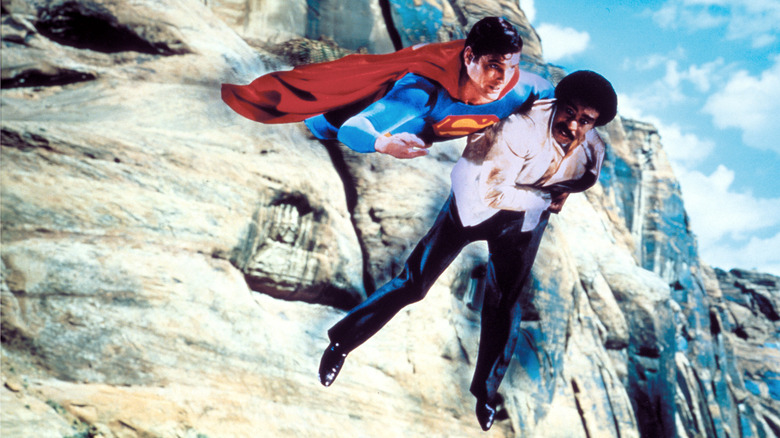
The plot of "Superman III" is more apt for a sitcom than a big-budget superhero film. In it, the legendary comedian Richard Pryor plays a hapless ne'er-do-well named Gus who, he finds, has an innate ability for computer programming. In the world of "Superman III," understanding (then-novel) computers was less a learned skill and more a secret superpower that only a chosen few possess. Gus uses computers to analyze and recreate Kryptonite in the hopes of weakening the Man of Steel. Kryptonite, however, is complex and alien, and Gus is not able to determine every element. He replaces the unknown parts with the tar found in cigarettes (!). The resulting Kryptonite turns Superman into an evil drunk.
Yes, it's all quite silly. The film's climax will feature a terrifying scene of a woman being forcibly turned into a robot by a malevolent machine intelligence. Pryor will be constantly present to crack wise. Gus plays a larger role in "Superman III" than even Superman. In his book, Christopher Reeve talks about how the producers were struck by a plea that Pryor idly made on a TV talk show one evening, and the entire movie was re-written to accommodate him:
"One night on the Johnny Carson show Richard Pryor raved about the Superman films and said how much he'd love to be in one. When they heard about it, [the film's executive producers] were excited by the idea that they might get Pryor to play some kind of comic villain in 'Superman III.' They approached him and received an immediate yes. David and Leslie Newman, the only writers left from the original group, were hired to write a movie that became more a Richard Pryor comedy vehicle than a proper Superman film."
Pryor Is Great, But...
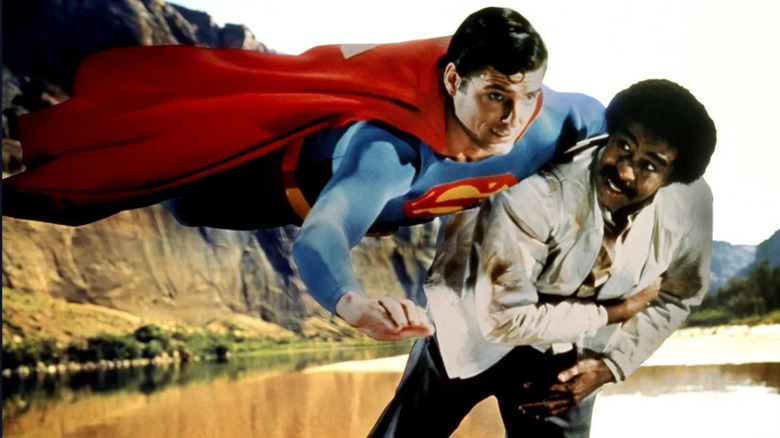
Note that Richard Pryor was a giant in the world of standup comedy, and had multiple hit films of his own. The issue was that a comedian was inappropriate for a series that had spent two films establishing Superman as a mythic, larger-than-life hero. Converting the series into a comedy was, by Christopher Reeve's estimation, a poor decision. He even highlighted a particular "Superman III" scene that would have felt more in place in a Sylvester/Tweety cartoon short than in a Superman movie:
"The Newmans wrote a scene in which Pyror, wearing skis and sporting a pink tablecloth as a Superman cape, zooms off a little ski slope on the top of a high-rise. He falls down the side of the building and land -- miraculously unhurt -- in the middle of traffic on a busy street, then waddles toward the sidewalk, oblivious to all the honking horns and staring pedestrians. I personally found all that in poor taste."
Reeve then added how much he missed working with Richard Donner. He did add, though, that "Superman III" had at least one notable scene. The cigarette Kryptonite eventually bifurcates Superman into separate good and evil beings, and the two of them fight. Reeve liked that, writing:
"I missed Donner tremendously, and what we'd created just two years earlier. I did enjoy the sequence in which Superman has become an evil version of himself and tries to kill Clark Kent in an automobile junkyard. That scene stands alone; I think the rest of 'Superman III' was mostly a misconception."
The Telly Savalas Joke
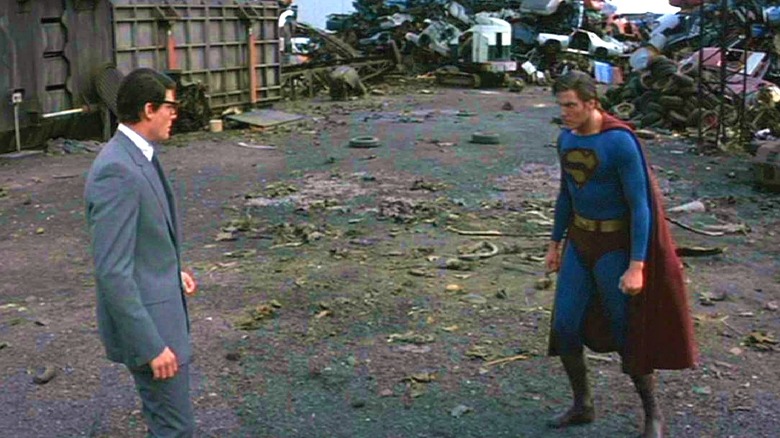
And it could have been even worse. Indeed, Richard Donner himself once complained about what might have been the worst, most whimsical gag in a Superman movie. It seems that multiple screenwriters and producers wanted "Superman" to be more broadly slapstick than it was, and someone actually thought to include a cameo from actor Telly Savalas, reprising his role from the hit 1978 detective show "Kojak." Yes, Savalas was to include his signature catchphrase. Wisely, the gag was written out. In Reeve's words:
"In the first draft of 'Superman' was a scene in which Superman sees a bald man walking down the street. Thinking it's Lex Luthor he swoops down to collar him and take him away. But it's Telly Savalas, who says, 'Who loves ya, baby?' to the startled Superman and offers him a lollipop. This was the kind of inane material that Dick Donner got rid of immediately."
Adapting Superman into a feature film seems weirdly difficult. Donner managed to make two excellent Superman movies in 1978 and in 1980 (Donner's intended version of "Superman II" was mostly salvaged for an eventual DVD release), but it has largely been downhill ever since. "Superman III" was silly, and the Cannon Group-produced "Superman IV: The Quest for Peace" was unbearably cheap. Tim Burton was infamously unable to make his "Superman Lives," while Bryan Singer's 2006 homage-sequel "Superman Returns" was more a monument than a film. Later, Zack Snyder's 2013 Superman film "Man of Steel" was clunky, overwrought, destructive, and nearly unbearable, often using florid prose to cover its overall aesthetic shallowness.
Another great Superman movie might be made someday, but the world is still waiting.
Read this next: Every DC Movie Made Prior To The DCEU Ranked From Worst To Best
The post Christopher Reeve Thought Richard Pryor's Casting Was What Sunk Superman III appeared first on /Film.
15 Fantastic Movies That Are Based On Banned Books
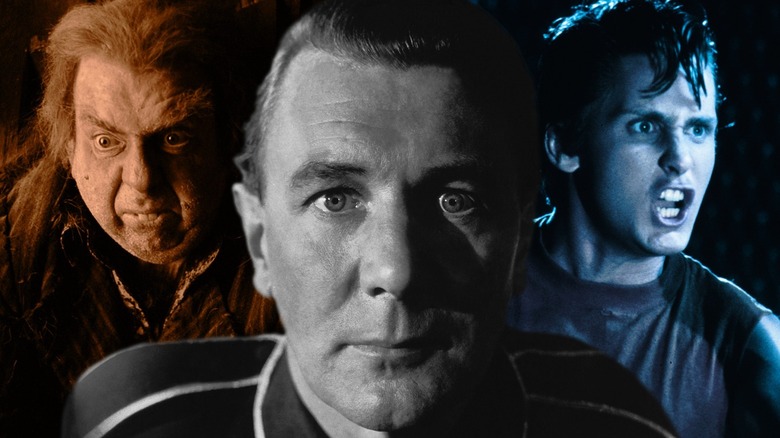
Ever since the printing press was invented, there's been no shortage of instances of books being banned. The reasons for these bans run the gamut from the religious to the political to the moral. Because the standards of decency have changed so much over the centuries, books that were once considered obscene are now socially acceptable, and sometimes, it's the other way around.
While the general intent of banning a book is to prevent readers from engaging with it, it often has the opposite effect. Labeling a book "forbidden" can bring more attention to it. This "Streisand Effect" makes a lot of sense. When the powers that be condemn a piece of media, this only increases the audience's curiosity about why it's so controversial. Not only have bans led to books becoming more popular, but it has also led to them getting the big screen treatment. Hollywood has rarely shied away from capitalizing on controversy, so, understandably, the film industry would see the furor around a contentious book leading to high ticket sales. Let's take a look at some fantastic movies that are based on banned books.
1984
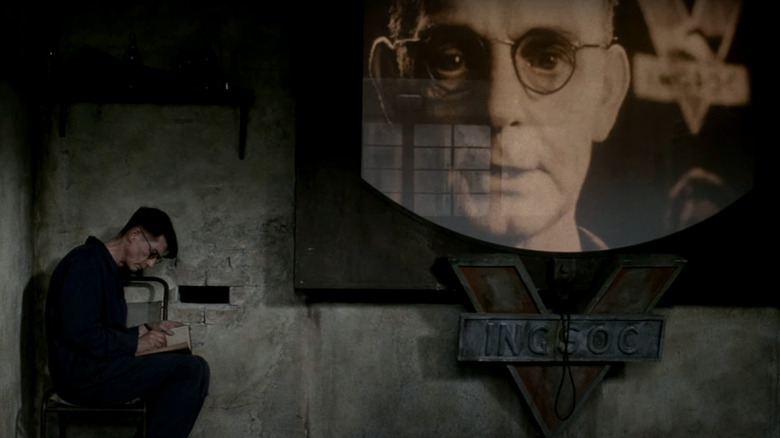
George Orwell's classic dystopian novel, "Nineteen Eighty-Four," is set in a future in which what was once Great Britain is under the totalitarian rule of Big Brother. This oppressive government keeps the population under strict control with constant surveillance, revisionist history, and even more deceptive tactics, all to prohibit individual thought. According to Reuters, because the Soviet Union was not exactly renowned for the freedom that its citizens enjoyed, is it any wonder that "Nineteen Eighty-Four" was banned there until 1988?
There have been numerous adaptations of Orwell's classic, but the best is director Michael Radford's (who also adapted the screenplay) version starring John Hurt and Richard Burton, released in well, 1984. Radford does a spectacular job depicting a hopeless and desolate alternate timeline where conformity is the law, and basic human emotions and thoughts are criminal. Hurt is terrific as the protagonist, Winston Smith, who, despite rewriting history for the Ministry of Truth, secretly desires a freer world. There's never a second that you doubt that this man has been beaten down by the might of enforced congruence.
Animal Farm
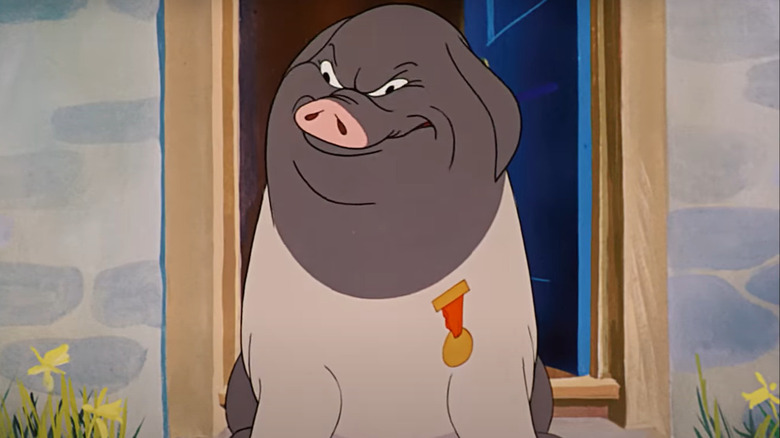
George Orwell's other classic work, "Animal Farm," follows a cadre of farm animals living at Manor Farm who are tired of living under the careless rule of Mr. Jones. They hatch a scheme to depose Mr. Jones and the other human owners to establish a community where they can all flourish. However, their efforts are undermined by the conniving pig Napoleon, who just wants to take power for himself. The American Library Association lists many instances of the book being banned around the world. In 1987, the Bay County school district in Panama City, Florida, banned the book. Thankfully, the restriction was lifted when 44 parents filed a lawsuit against the school district.
"Animal Farm" was made into a pretty faithful animated film in 1954, a bold move considering most animated films at the time were geared towards children. The art is stellar and was some of the best non-Disney animation around when it was released. The film generally doesn't shy away from the deeper themes of the source material, giving it a weightier intellectual punch than anything Disney ever put out. However, its one glaring flaw is an upbeat ending that largely contradicts what Orwell originally wrote.
Catch-22
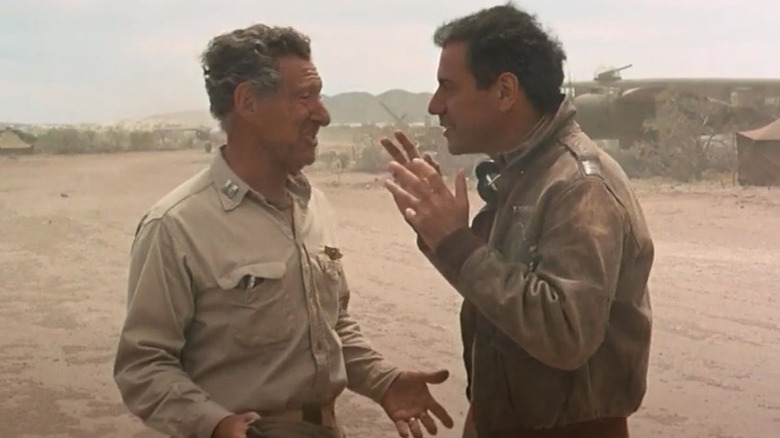
Joseph Heller's satirical war novel, "Catch 22," takes place during WWII and tells the story of Capt. John Yossarian of the U.S. Army Air Forces as he and his fellow soldiers try to keep from going crazy during wartime. The book is an incisive look at the absurdity of war, alternating from lighthearted to tragic as it explores how enemies aren't only those on the other side of a fight. As documented by NBC News in 2020, the Mat-Su Borough School District in Alaska added it to a list of other famous books to be banned from the curriculum, largely because of its violent content.
Mike Nichols (of "Who's Afraid of Virginia Woolf?" and "The Graduate" fame) directed the 1970 adaptation of Heller's novel, which manages to mostly recreate the same balance of wit and agony in the book. Fans of the novel may be a little bothered by the fair amount of material that was cut out to accommodate a feature-length runtime, but what is in the movie — the splendid cast, the dark humor, the horrors of war — is more than enough to demonstrate that Nichols and screenwriter Buck Henry understood the book.
The Color Purple
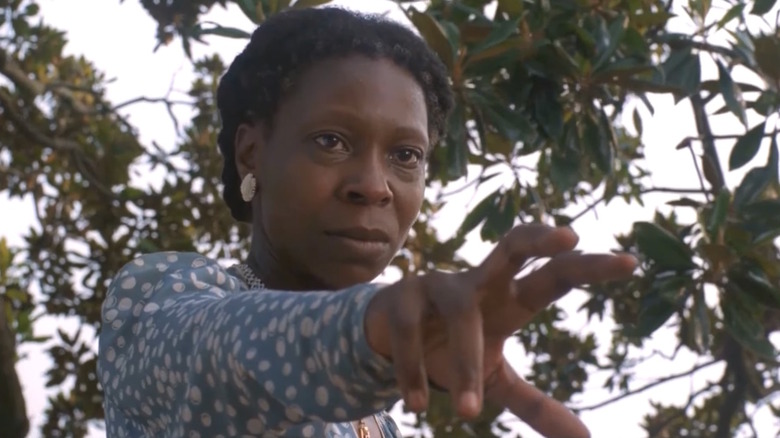
Released in 1982, "The Color Purple" is a Pulitzer Prize-winning novel by Alice Walker. Set in Georgia in the early 1900s, the story follows a young Black woman named Celie as she describes the brutality of her life through letters to God. The Washington Post reported on a 1997 case wherein the Jackson County School Board in West Virginia voted to ban "The Color Purple," as it was believed that it "could lead to different sex games and violence and other things."
Steven Spielberg took the reins in directing the adaptation of Walker's controversial novel and does a superb job translating the powerful ideas of the source material to the big screen. While the film suffers a tad from Spielberg's characteristic saccharine sensibility, the stunning performances from the cast more than compensate for it. Whoopi Goldberg's portrayal of Celie is particularly stirring, giving the film the majority of its emotional heft and earning her a much-deserved Oscar nod. Oprah Winfrey, as the fiery Sofia, and Danny Glover, as the abusive Albert, are also standouts.
Elmer Gantry
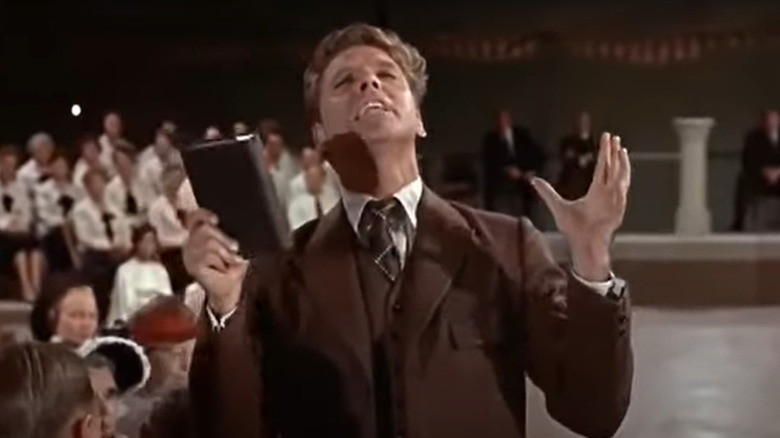
Written by Sinclair Lewis, "Elmer Gantry" takes a darkly comedic look at fundamentalist evangelical Christianity in 1920s America. The title character is a womanizing, alcohol-abusing young man who becomes a Methodist minister despite retaining his various sexual and substance-based vices. Right after it was published, the New York Times reported that it was banned in Boston, and District Attorney William J. Foley warned Suffolk County that stores that sold the book would face serious legal action.
Burt Lancaster knocks it out of the park as the title character, stealing every scene he's in with his portrayal of the sleazy-businessman-turned-sleazy-preacher. Lancaster's versatility is on full display with his ability to pull off a character who can both shock a congregation with fire-and-brimstone verse and make the drunken patrons of a dive bar laugh with a dirty joke. Shirley Jones is also terrific in "Elmer Gantry." The actress established herself playing sweet and innocent characters, but she completely loses herself in the role of an illegal sex worker out for revenge.
The Harry Potter Series
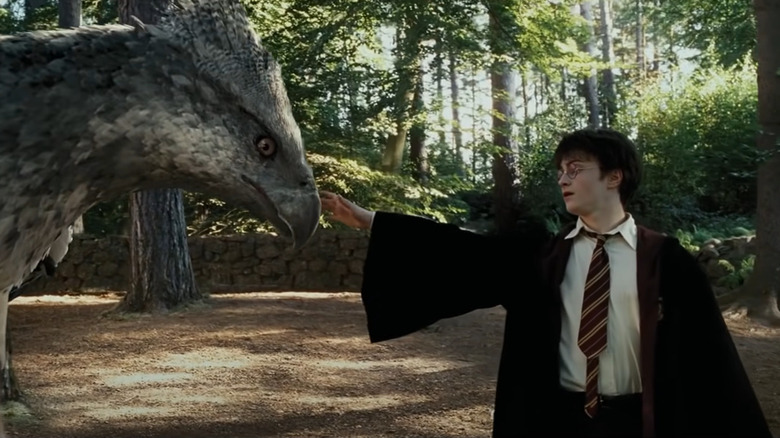
J. K. Rowling's "Harry Potter" novels need little introduction. Ever since "Harry Potter and the Sorcerer's Stone" was released in 1997, the books have attracted countless readers who have delighted in the story of the eponymous young wizard and his adventures at Hogwarts School of Witchcraft and Wizardry. However, according to the Tennessean, St. Edward Catholic School in Nashville, Tennessee, banned the books from its library. The school's pastor, Rev. Dan Reehil, stated that the series could "risk conjuring evil spirits into the presence of the person reading the text."
Despite the controversies generated by the books, their cinematic counterparts have been pretty spectacular. No expense was spared in bringing the magical world of the "Harry Potter" novels to the big screen. There's some inconsistency in style and tone due to the different directors and cast changes. However, the main cast of Daniel Radcliffe, Emma Watson, and Rupert Grint as Harry Potter, Hermione Granger, and Ron Weasley, respectively, are the emotional anchors of the series who kept audiences engaged for over ten years.
Gone With The Wind
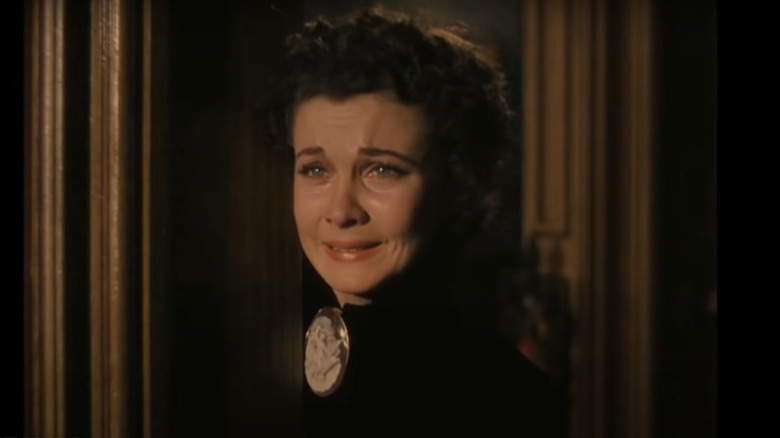
Margaret Mitchell's 1936 novel, "Gone with the Wind," spans the American Civil War and Reconstruction. It's the story of Scarlett O'Hara, who hails from a wealthy family in the South that loses everything during the war, and her attempts to win the object of her affection, the charming Rhett K. Butler. The Coloradoan chronicled some of the times "Gone With the Wind" has been banned. While the racist content continues to spur debate (and understandably so), the most surprising bans of "Gone with the Wind" occurred in Nazi Germany and Soviet Russia — because of its depiction of people surviving during wartime.
The film's production values, costumes, and attention to historical detail still hold up remarkably well, paving the way for the massive period pieces that still get made. Of course, because of its faithfulness to the book, what doesn't hold up well are the racial elements. After all, the story ultimately asks the viewers to sympathize with a wealthy Southern family during the Civil War. Still, with its touching love story, majestic battle sequences, and epic yet intricate narrative, it's easy to see why "Gone with the Wind" is still regarded as one of the greatest movies of all time.
Lord Of The Flies
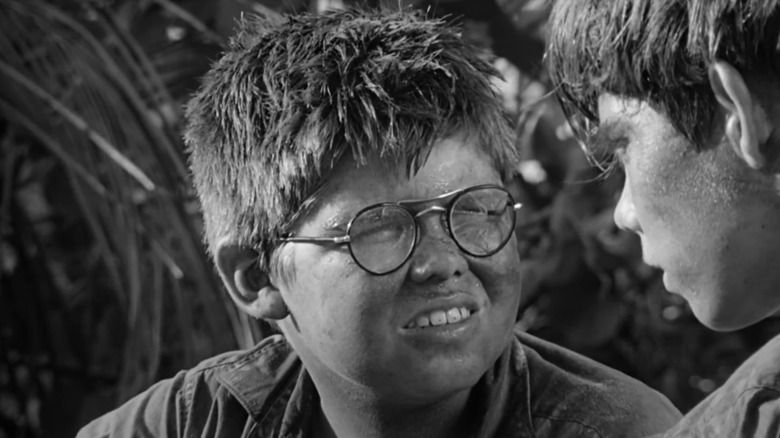
This classic 1954 novel tells the story of a group of young British schoolboys who st are stranded on an island in the Pacific Ocean after their plane crashes during an evacuation. While the boys initially work together to ensure their survival, they soon begin to fight over who should be in charge and turn against one another. As reported by True North in 2021, the Ottawa-Carleton District School Board voted to remove it from the English curriculum of all of its schools for its alleged themes of "white male supremacy."
While "Lord of the Flies" has been translated to the big screen on two occasions (in 1963 and 1990), the first cinematic adaptation is the superior one. It's not only more faithful, but the child actors playing the stranded boys are phenomenal. There's never a second that you doubt that this is how a group of adolescent males would act while trying to survive on an island without adults. The film is not quite as dark as the source material. However, it remains utterly faithful to its themes of order versus chaos, the corrupting influence of power, and the individual versus the group.
The Grapes Of Wrath
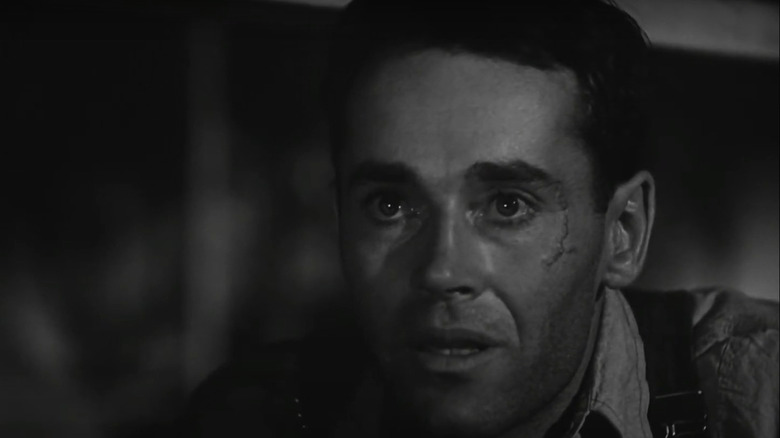
"The Grapes of Wrath" is one of John Steinbeck's greatest works as well as one of the most celebrated American books of the 20th century. The novel follows the Joad family as they make their way through an America devastated by the Great Depression. The Joads struggle with a difficult itinerant life as migrant workers while much of the country deals with intense hardship. As detailed by NPR, upon the book's release, it was banned in Kern County, California, where the county board of supervisors denounced its portrayal of their fair county.
Still, the controversy "The Grapes of Wrath" inspired didn't stop Hollywood from turning it into a feature film — and a damn good one, too. Legendary film director John Ford gives us an uncompromising look at the misery and adversity that farm workers had to endure during one of the toughest times in American history, faithfully recreating the sorrow of the book. Grounding the film are the performances of Henry Fonda and Jane Darwell as Tom and Ma Joad. Rarely has Fonda elicited such sympathy without coming off as sappy, and Darwell is perfect as the mother who will stop at nothing to preserve any shred of hope.
The Great Gatsby (1974)
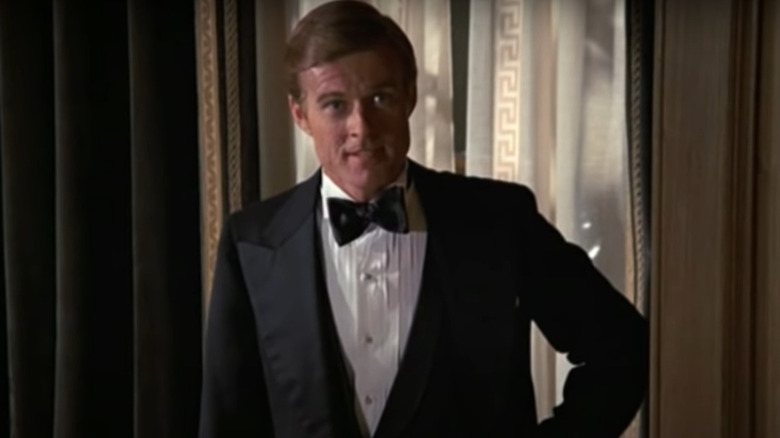
Written by F. Scott Fitzgerald, the great scribe of the Jazz Age, "The Great Gatsby is told through the perspective of Nick Carraway, who meets the charming yet mysterious socialite Jay Gatsby. It's gradually revealed that Gatsby is looking for his past lover, Daisy Buchanan, who just happens to be Carraway's cousin, but is stuck in a loveless marriage. NBC News reported that in 2022, Mat-Su Borough School District in Alaska voted to ban several classic works, including "The Great Gatsby," for its "sexual references."
The novel has been adapted for the big screen several times, the most recent of which is Baz Luhrmann's over-the-top version. However, the best of the bunch is still the 1974 translation, written by Francis Ford Coppola of "The Godfather" fame. Robert Redford is perfect in the role of Gatsby. His immense charm is balanced with a nervous longing for Daisy, who's portrayed almost as wonderfully by Mia Farrow. While the extreme fidelity to the source material robs the film of some of its emotional heft (it sometimes seems like the characters are simply repeating lines from the novel as opposed to depicting their subtext) director Jack Clayton and writer Coppola treat "The Great Gatsby" with the respect it deserves.
To Kill A Mockingbird
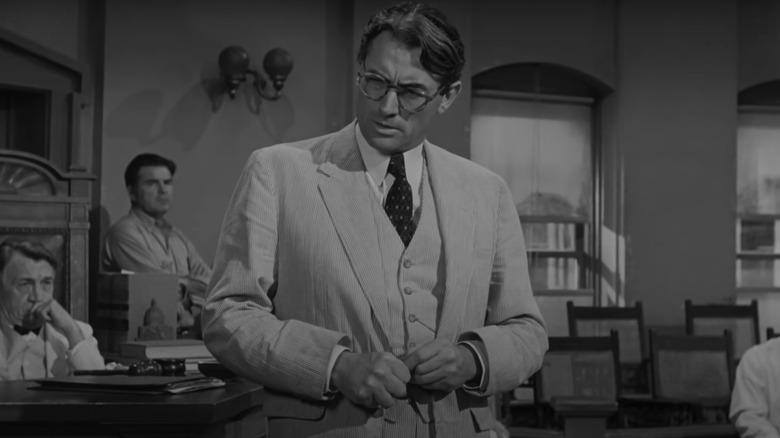
Harper Lee's Pulitzer Prize-winning "To Kill a Mockingbird" is set in a small Alabama town during the Great Depression and is told through the perspective of the young Jean Louise Finch, aka Scout. Scout's lawyer father, Atticus, must defend a Black man who's been falsely accused of raping a white woman in a case that has larger ramifications for everyone in town. A recent example of this classic being banned was when the Mukilteo School Board in Everett, Washington, decided to remove it from the ninth-grade curriculum because of its racist elements.
The film adaptation of "To Kill a Mockingbird" was released in 1962, two years after the book was published. Don't let that quick turnaround worry you, as director Robert Mulligan and screenwriter Horton Foote craft the finest translation from page to screen possible. All of the source material's themes (the brutality of racism, the danger of prejudice, and the corruption of the justice system) are faithfully carried over into the film with much of their power intact. However, the real gem of the film is Gregory Peck as Atticus Finch, who becomes the person that everyone imagines when they read the novel.
If you or anyone you know has been a victim of sexual assault, help is available. Visit the Rape, Abuse & Incest National Network website or contact RAINN's National Helpline at 1-800-656-HOPE (4673).
Of Mice And Men (1992)
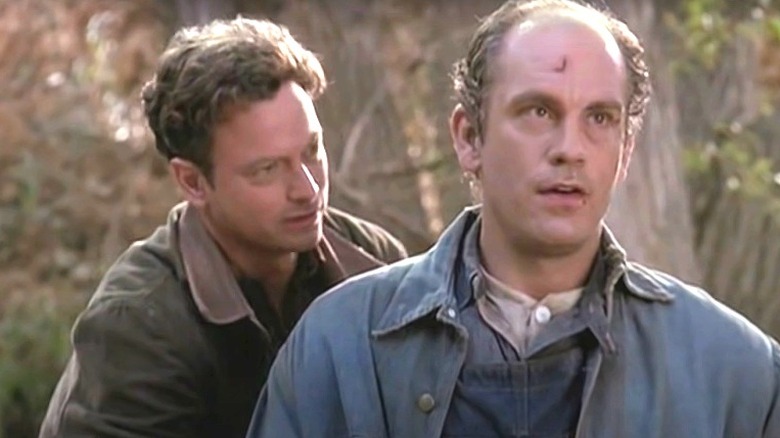
Written by John Steinbeck, "Of Mice and Men" follows migrant workers George Milton and Lennie Small as they escape from Weed, California, after Lennie is falsely accused of rape. They search for a new town to work in, only to encounter further troubles. WLOX states that in 2003, members of the George County, Mississippi, school board voted unanimously to remove the book from both the curriculum and from school libraries due to its profanity.
Part of what makes John Steinbeck so enduring is his straightforward prose, which makes his works accessible to almost every reader. That same approach is taken with the 1992 adaptation of "Of Mice and Men," resulting in a lean film uncontaminated by the melodramatic flourishes Hollywood often shoves into big-budget adaptations. Gary Sinise, who also directs the film, is terrific as George, striking just the right balance of ruggedness and heart. Still, it's John Malkovich who steals the show, capturing Lennie Small's childlike innocence, which makes his demise every bit as tragic as depicted in the source material.
If you or anyone you know has been a victim of sexual assault, help is available. Visit the Rape, Abuse & Incest National Network website or contact RAINN's National Helpline at 1-800-656-HOPE (4673).
Slaughterhouse-Five
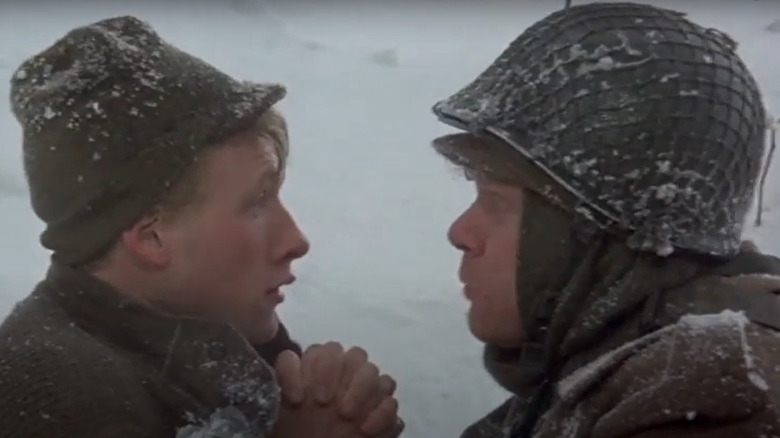
Kurt Vonnegut's 1969 novel centers on Billy Pilgrim, who inexplicably gets tossed around through time, revisiting various events from his life. Throughout his bizarre time-traveling escapades, Pilgrim relives his time as a sloppy soldier in the United States Army, his capture by Nazi forces, and his abduction by aliens to the distant planet of Tralfamadore. CBS News states that in 2011, "Slaughterhouse-Five" was banned from the curriculum and library of Republic High School in Missouri due to the complaint of one parent.
Anyone who's read "Slaughterhouse-Five" knows that it's practically unfilmable, yet director George Roy Hill (mostly) pulls it off. Michael Sacks is given the unenviable job of playing multiple versions of Billy Pilgrim, seamlessly transitioning from one iteration of himself to another without missing a beat. While the hectic plot of the complex novel had to be streamlined for a feature-length film, Hill capably retains the wry wit and sardonic spirit of the novel, a monumental feat to be sure. Even Vonnegut approved, stating in the preface of his 1972 teleplay, "Time and Timbuktu," that "I drool and cackle every time I watch that film, because it is so harmonious with what I felt when I wrote the book."
Sophie's Choice
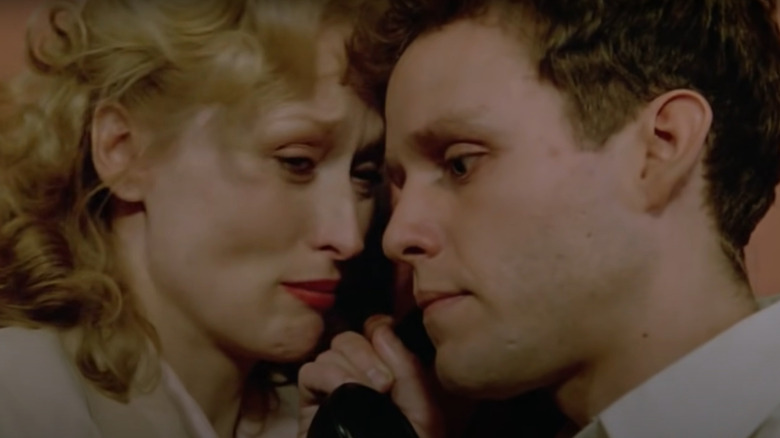
"Sophie's Choice" tells the story of a man named Stingo who lives in a Brooklyn boarding house where he meets Nathan Landau and Sophie Zawistowska. Stingo befriends Sophie, who recounts her time in a Nazi concentration camp and wrestles with her terrible experiences and the horrible decisions she was forced to make there. The New York Times reports the book was banned in South Africa. While no official reason was given, author William Styron speculated that it may have been its sexual content.
The 1982 film version of "Sophie's Choice" is just as wrenching in its portrayal of the atrocities of history and the tortured love story that came out of them. It intricately navigates the difficult decisions that the characters make throughout the film without overexplaining them, letting the audience grapple with the moral conflicts presented. The casting, though, is the film's real strength. Meryl Streep is stellar as the title character, displaying the full range of human emotions while never resorting to the sentimental theatrics a lesser actress might have employed.
Lolita

"Lolita," written by Vladimir Nabokov, follows a teacher known only as Humbert Humbert, who, after moving into widow Charlotte Haze's home, falls in love with her 12-year-old daughter, Dolores (whom he calls Lolita in private). Humbert soon marries Charlotte simply to get closer to his new stepdaughter, but complications abound when the two become romantically involved. According to the Guardian, "Lolita" has been banned in numerous countries, including France, Argentina, New Zealand, South Africa, Australia, and the United Kingdom, because of its themes of pedophilia.
The contentious novel has been adapted for the screen twice (in 1962 and 1997), but it's the first version you should see, as it's directed by one of the giants of cinema, Stanley Kubrick. Fortunately, the sexual elements of the source material are greatly downplayed. Kubrick expertly relies more on suggestion and subtlety to depict the problematic romantic relationship between an adult man and an adolescent girl. Still, the material is pretty explicit, even by today's standards. James Mason excels as Humbert, starting as a respectable academic whose infatuation with the title character gradually drives him desperately bonkers by the film's end.
Read this next: The 19 Greatest Movie Couples Of All Time Ranked
The post 15 Fantastic Movies That Are Based on Banned Books appeared first on /Film.
Chris Rock Couldn't Help But Think Of Chris Farley During Adam Sandler's Uncut Gems
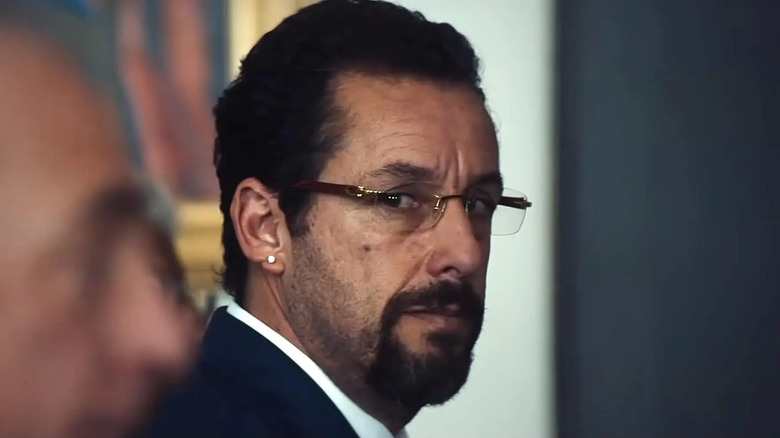
The career of Adam Sandler has been frequently surprising. On "Saturday Night Live" in 1990, Sandler gained a reputation for playing a puckish, rude, doofus. It was a squeaky, occasionally explosive stage persona the actor would carry over into some of his mid-'90s comedy vehicles like "Billy Madison" and "Happy Gilmore," and would go on to serve as the foundation of his production company. Any number of Sandler's comedy films are crass, prurient, and often venerate the bad behavior of their leads. Also, as a curious motif, Sandler's comedies often employ American pop culture iconography of the 1980s.
But then Sandler will occasionally startle audiences by proving himself as something beyond his usual "dip" persona. In "The Wedding Singer," Sandler emerged as a convincing romantic lead opposite Drew Barrymore. In "Punch-Drunk Love," director Paul Thomas Anderson tapped into Sandler's ever-present rage but balanced it with a truly disarming love story. And in Josh and Benny Safdie's 2019 film "Uncut Gems," Sandler continued to prove that he was a great actor, creating a foolish yet understandable character who audiences couldn't help but like. Indeed, Sandler, by all anecdotal reports, is a relentlessly decent person, and many actors and comedians love working with him, even if his comedies are typically dumb and crass.
One such comedian is Chris Rock, who has appeared in seven feature films with Sandler. Rock, like many, loved "Uncut Gems," but he couldn't help but think of an old colleague in Sandler's role. In a 2022 interview with the "Fly on the Wall" podcast, transcribed on Cinemablend, Rock admitted that watching Sandler acting evoked a pang for the late Chris Farley, the "SNL" alum and movie star who died in 1997 at the age of 33. Farley, Rock feels, would have eventually been due for a renaissance.
Chris Farley Forever
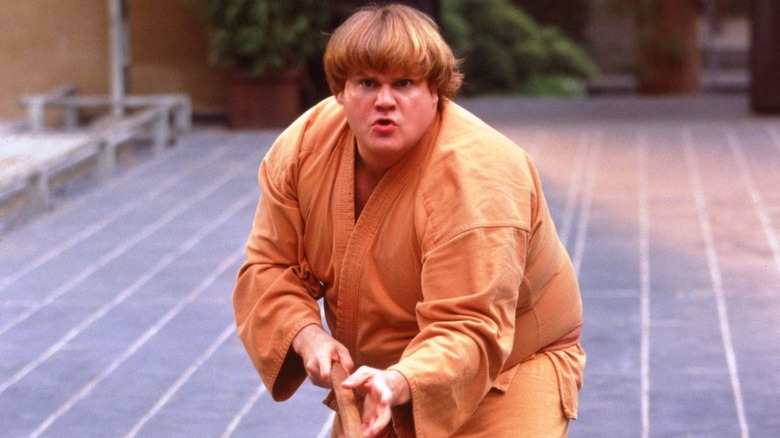
Farley began appearing on "Saturday Night Live" in 1990, the same year Rock joined the cast. He was part of a new generation of comedians that some felt were a new breed of "bad boys." He was known for his awkward personae and his over-the-top screaming. Many are fans of Farley's Matt Foley, a character who announced repeatedly that he lived in a van down by the river. Farley also starred in several feature films, a few of them opposite co-"bad boy," David Spade. In his films, Farley often played a broad, clueless doofus, serving as a perfect comedic foil for Spade's own eye-rolling sarcastic jerks. Farley, sadly, never appeared in a drama.
Rock feels that he could have. Farley wrestled with substance addiction for most of his life and frequently suffered from numerous health problems. It would be cocaine and morphine that would eventually take his life. Rock envisions a parallel universe where Farley kicked his drug habit, turned his acting toward drama, and succeeded immensely. Rock had every faith in Farley's acting abilities and saw "Uncut Gems" as exactly the type of role he could have been playing. Rock said:
"It's sad when our friend's not here, but it is curious to [think], 'Wow, what would that guy have done?' When I see Sandler in something like 'Uncut Gems,' it's like, 'Yeah, Farley could have done that. Farley could have been in, you know ...' He's literally that level of actor, and that level of, like ... you just felt for that guy. Whatever ride Chris Farley was gonna to take me on, I was definitely ready to go on it."
The Farley Films We Never Saw
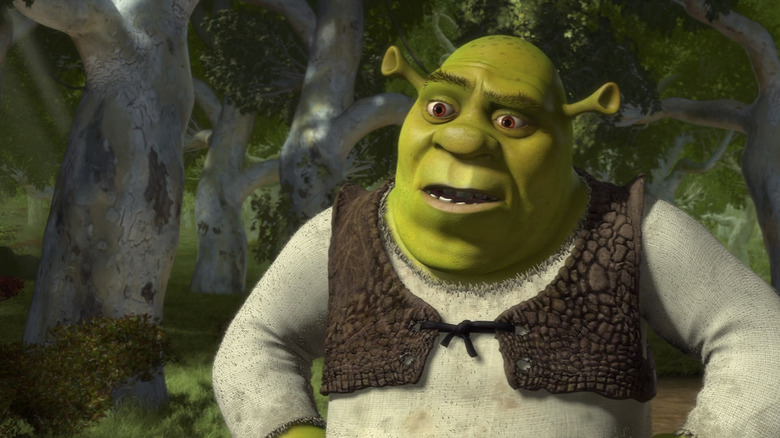
Farley's films, while broad, were generally successful, and he was beloved by his peers. He also continued to seek film work, with some projects that would have doubtless seen his star rise even further. Indeed, Farley had even recorded dialogue for the movie "Shrek" shortly before his passing, hoping to star in what would eventually become a pop culture juggernaut. Some early storyboards featuring Farley's voice can be found online. Farley was ultimately replaced by another "SNL" alum, Mike Myers. The same "Fly on the Wall" podcast revealed that Farley only had five days of voice work remaining for "Shrek" when he died, and his sound-alike brother John was asked to finish the work for him. John was too distraught to do it, however.
Farley was also set to play one of the dinosaurs in the 2000 Disney animated film "Dinosaur," and some might recall the 2009 news about Farley joining the cast of a new "Ghostbusters" film. It was also said that celebrated children's author Dav Pilkey had hoped Farley would play the title character in a live-action film adaptation of the "Captain Underpants" books. In a dramatic shift, Farley was also one of the many actors in contention for playing Ignatius J. Reilly in a potential film adaptation of John Kennedy Toole's Pulitzer-winning novel "A Confederacy of Dunces."
One can only imagine Farley's dramatic career after that. Rock seems to feel that Farley was capable of soulful work far beyond his usual "dumb guy" shtick. It's also notable that the people who met Farley often came away loving him. It's been over 25 years since his passing. R.I.P., Mr. Farley. I wish you could have surprised us.
Read this next: All 10 Chris Farley Movies, Ranked Worst To Best
The post Chris Rock Couldn't Help But Think Of Chris Farley During Adam Sandler's Uncut Gems appeared first on /Film.
Supreme Court Snubs Wikipedia Bid To Challenge NSA Surveillance
Read more of this story at Slashdot.
Google Warns Internet Will Be 'A Horror Show' If It Loses Landmark Supreme Court Case
Read more of this story at Slashdot.
The Bad Batch Takes Star Wars To The Temple Of Doom
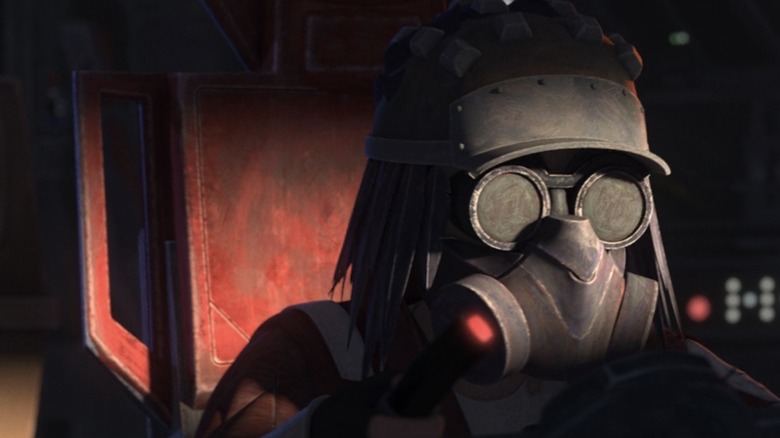
The tenth episode of "The Bad Batch" is called "Retrieval" and it's the second half of last week's episode. The Batch (Dee Bradley Baker) and Omega (Michelle Ang) are stranded on a distant mining planet, and their ship has been stolen by a mysterious thief. Now, they await rescue from a very grumpy Cid (Rhea Perlman). But Omega tracks the ship to a mining settlement barely 100km away and they make their move.
In this settlement, they find a Dickensian colony of kids, mining and stealing on behalf of a mobster named Mokko (Jonathan Lipow). A young thief named Benni (Yuri Lowenthal) is the one behind the theft of the Marauder and hopes to earn enough goodwill to eat and drink well.
Naturally, the Bad Batch wants their home back and they infiltrate the mining settlement. Along the way, tables turn back and forth with Benni, who is at times helping them and then turning on them and then helping them again. Eventually, the group of specialized Clones uncovers Mokko's greed, and the kids of the mine turn on the mobster, leaving the mine in their care.
With their ship back, the Bad Batch takes to the stars once more, ready to take on another mission.
Indiana Jones And The Temple Of Doom
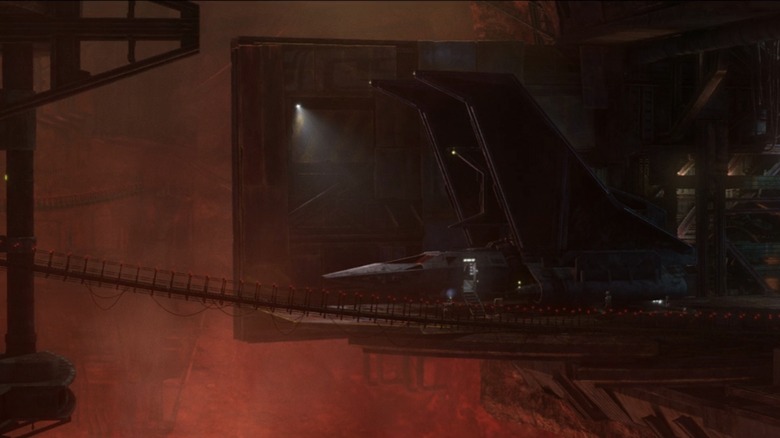
Once again, this episode goes straight to the well of "Indiana Jones" inspiration. The ipsium mine looks and operates very much like the mine of children enslaved by the Thugee in "Temple of Doom," replete with red steaming mist and mysterious music (compliments of Kevin Kiner and co.). Under Mokko's thumb, the kids barely scrape by, while he takes all of the wealth for himself. The Bad Batch shows up and fills in the role of Indiana Jones, acting as the force that turns the tide on the evil overlord and rescues the children.
The final standoff of the episode even happens on a bridge across a wide-open chasm, just like the end of "Temple of Doom." Instead of the hero being caught in the middle, though, it's Mokko himself, beset by everyone. He falls into the mist of the mine, much like Mola Ram in the Indy picture. The kids finally turn on their enslavers much the same way as the kids trapped in Pankot Palace, but instead of returning home to their own village, they seize the means of production and start to work for themselves.
It's an incredibly positive note for these kids, and reinforces the anti-capitalist Empire sentiment of "Star Wars."
Details To Watch Out For
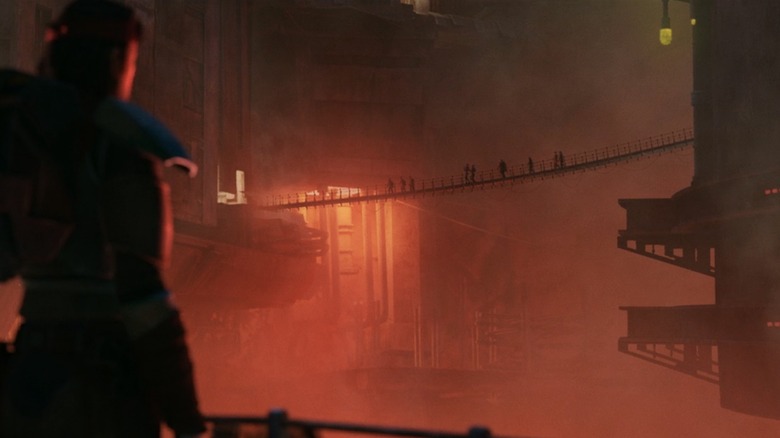
The isolation of this planet keeps it away from a lot of the more obvious places references get dropped into the show, but there are certainly some cool things to check out.
The first is Benni. Benni is voiced by Yuri Lowenthal, who a lot of folks might recognize as Ben Tennyson from "Ben 10" or as Peter Parker/Spider-Man in the Insomniac Games "Spider-Man" series. He has an undeniably youthful bent to his voice that makes him perfect for this character. As far as Benni's physical appearance, his goggle-eyed disguise from the last episode and the beginning of this one recalls a very specific design from the animated iteration of "Battle Angel." In that show, a character named Yugo is disguised as a Hunter Warrior. Like Benni, Yugo has to scrap on the street to survive in a hostile environment, and their costumes feel very similar when they're out doing those sorts of covert missions.
Benni's part of a group run by Mokko that feels similar to the way Lady Proxima runs the White Worms crew — where Han Solo got his start — in "Solo: A Star Wars Story."
The other thing to note is that this mine had been formerly owned by the Techno Union, according to Benni. The Techno Union lent their army to the Separatists in "Attack of the Clones," sitting at a negotiating table on Geonosis with Count Dooku. The mine itself evokes imagery from "Attack of the Clones" as well, echoing some of the designs of the Droid Factory on Geonosis.
Positive Messages
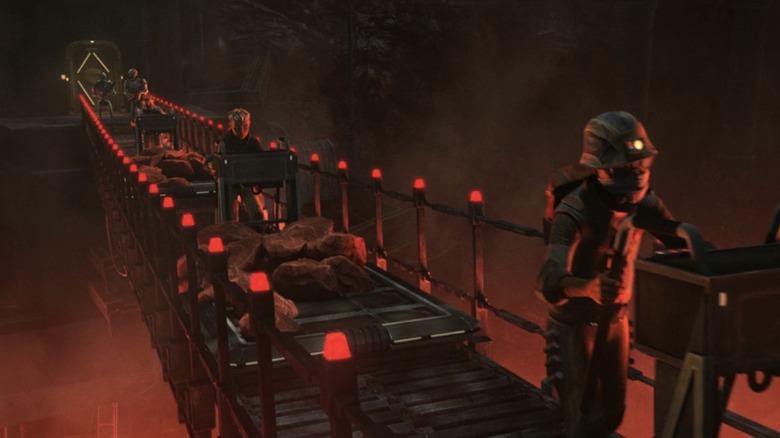
There's something inherently satisfying about an alleged kid's show having episodes that are very pro-labor. "No one should have to compete for food," Omega tells Benni at one point, sowing the seeds for the revolution that will take place in the mine. Labor history is full of moments where the workers seize the means of production from their evil overlords and most of them weren't this bloodless. I love that it has ties to Dickensian themes, casting Benni as Oliver Twist to Mokko's combination of Fagin and Sikes.
I always love taking stuff like Dickens and "Indiana Jones" and mixing it up with "Star Wars." Layer that on top of the western tropes in this episode (just like those we talked about last week) and you've got a really great episode. More than that, it shows the growth of Omega. She struggled in the last episode with the concept of home and listening to her talk to Benni about his struggle with the same thing was great work. He's in a clearly abusive relationship with his home, but she manages to help him through that struggle.
There's not a lot here that gets into the larger galactic conflict, but it definitely ends on a note where the Bad Batch realizes they need to start taking sides because there are bad guys everywhere.
New episodes of "The Bad Batch" air on Wednesdays on Disney+.
Read this next: Star Wars Characters That Are More Important Than You Knew
The post The Bad Batch Takes Star Wars to the Temple of Doom appeared first on /Film.
David Harbour Thinks It's Time To End Stranger Things
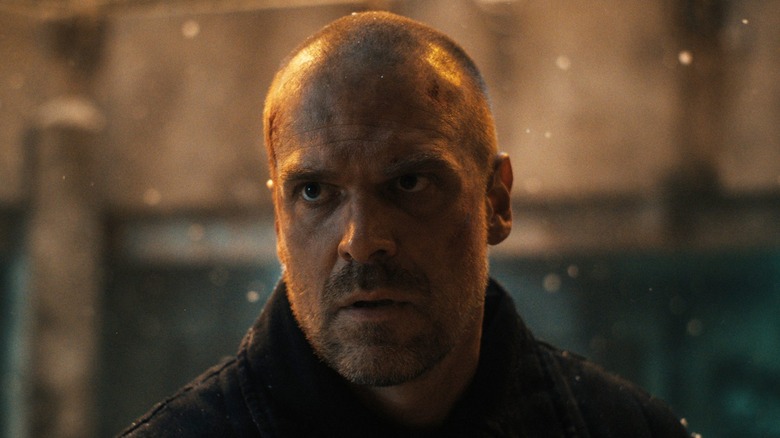
As some robot guy once said, "a thing isn't beautiful because it lasts." That's a difficult lesson to learn, especially in the entertainment business. It's doubly difficult when a massive franchise like Netflix's "Stranger Things" is concerned; each successive season of the hit series manages to capture the attention of all of pop culture upon dropping, resulting not only in a deluge of memes and discussions online but sales of copious merchandise items. Heck, the show even found time to resurrect Kate Bush's back catalog during season 4!
Yet all things must pass, and as the actors who began the show as children start to literally age out of their roles, it's becoming clear to all involved that the end is near. There's also the sense from a story perspective that things need to be resolved, as the supernatural forces menacing the small town of Hawkins, Indiana close in on our older, wiser heroes.
That's the vibe surrounding the upcoming fifth and final season "Stranger Things," and it's one that star David Harbour, who portrays town sheriff and ex-Russian prisoner Jim Hopper, agrees with. Just because the end is nigh, however, doesn't mean that it's a bad thing.
'I Never Ever Wanted It To End'
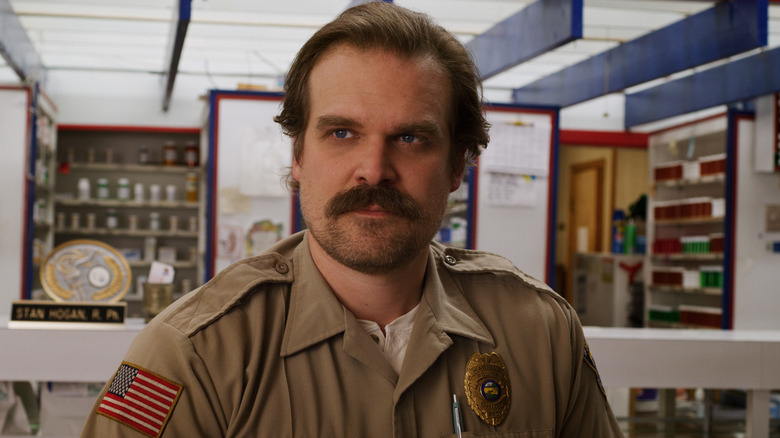
One of the most enjoyable elements of "Stranger Things" is the way its ensemble cast seems to be having an absolute blast making the show. (Netflix probably wouldn't release so many blooper reels online if that weren't the case.) Unsurprisingly, that's exactly how the cast seems to feel if Harbour is any indication. Speaking to DiscussingFilm in anticipation of the release of his new movie "We Have A Ghost," Harbour revealed his initial feelings about the show upon making the first season by saying, "What's funny is when I started the show, I never ever wanted it to end. That's why I love the show. I think it's a great show, even if I wasn't in it."
Harbour isn't being facetious or glad-handing here — after all, who can forget his impassioned speech celebrating the show upon its winning Outstanding Performance in an Ensemble in a Drama Series at the SAG Awards in 2017? Harbour has always been one of the show's biggest cheerleaders, so it's telling if even he knows it's time to say goodbye.
Time To Grow Up
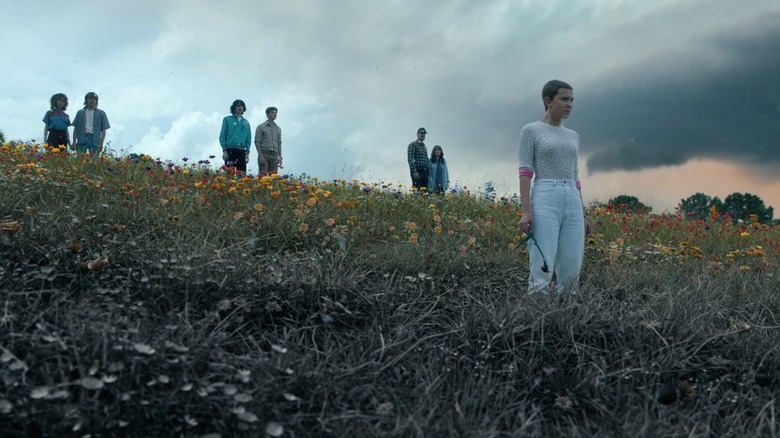
Still, Harbour is well aware that time has caught up to the show in more ways than one. As he continued:
"Now we're almost nine years from filming the first season, and I think it is time for it to end. But it is, of course, very bittersweet. You know, there's a sadness there. But also, we've all grown up. It is time for us to leave that nest and try other things and different projects."
Of course, Harbour is referring to himself and his fellow cast members with that sentiment. Yet he is quick to point out that it's the next move for show creators the Duffer Brothers (Matt and Ross Duffer) that he's particularly eager to see. "I mean, those guys are so talented," he said. "I want to see what they come up with next."
While the Duffers' next move isn't super clear yet, as they seek to develop a "Stranger Things" spin-off for someone else to take over and an adaptation of Stephen King's "The Talisman" that they're behind, Harbour's career continues to soar. In addition to "We Have A Ghost," the actor has the "Gran Turismo" movie on deck, as well as another appearance in the Marvel Cinematic Universe as Red Guardian in the upcoming "Thunderbolts" feature.
Still, Harbour will miss his "Stranger Things" family, even though it's clear to him that an ending is necessary: "it is bittersweet, but it's definitely time," he said. For Harbour, the rest of the cast, and us fans of the series, let's hope that the ending is a great one. But not too mean, okay, Duffers?
Read this next: Our Biggest Predictions For Stranger Things Season 5
The post David Harbour Thinks It's Time to End Stranger Things appeared first on /Film.
Harrison Ford Cut The Movie Acting BS Out Of Indiana Jones And The Dial Of Destiny
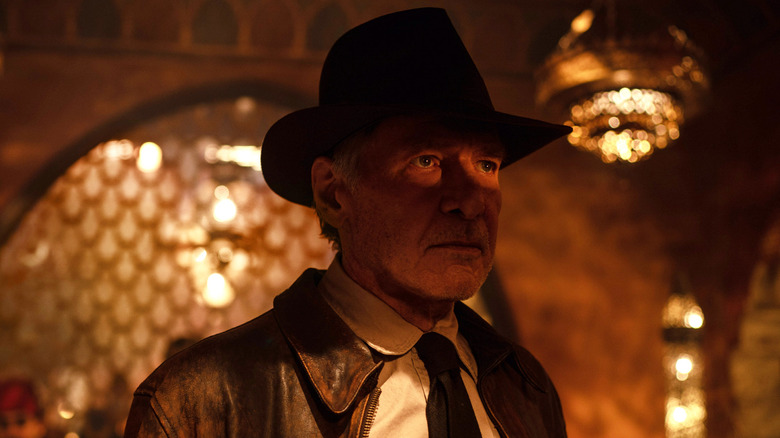
Harrison Ford nearly torpedoed his career early on as a member of Columbia Pictures' New Talent Program in the 1960s. The wet-behind-the-ears actor had the stature and looks of a born movie star, but he didn't want to coast on his physical gifts. When a studio executive told him Tony Curtis had famously distinguished himself as a star by popping off the screen as a delivery boy, Ford countered that Curtis had blown the assignment by being a star, not a delivery boy.
Ford stuck to his code as an actor by tending to the needs of his characters in classics like "American Graffiti" and "The Conversation," rather than trying to blow Paul Le Mat or Gene Hackman off the screen. He waited until a part called for him to throw the switch, at which point he gave us an intergalactic scoundrel whose cocksure charm is repeatedly undercut by his leap-without-looking decision-making.
We love Han Solo because he knows he doesn't know best half the time, but a rogue's gotta keep up appearances. We adore Indiana Jones because he's a scholar who does know more than most, but that doesn't preclude him from bumbling into the more-than-occasional tight spot. Ford has an effortless facility for making heroism look really goddamn hard. As Indy tells Marion Ravenwood (Karen Allen) in "Raiders of the Lost Ark," "It's not the years, honey, it's the mileage." Ford famously improvised that line, and it's one of the most endearingly honest confessions you've ever heard from an action-adventure protagonist. It hurts like hell to keep coming out (barely) on top.
A Movie Star With No Tolerance For BS
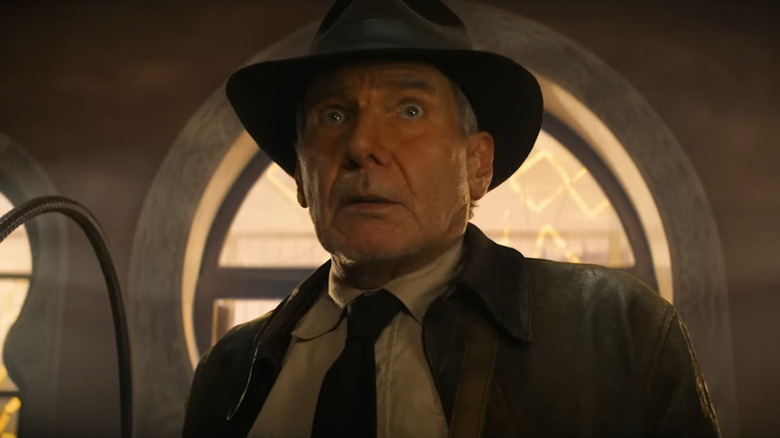
James Mangold is in the enviable/precarious position of being the first person not named Steven Spielberg to direct Ford as Indiana Jones in a feature-length film. After the crushing disappointment of "Indiana Jones and the Kingdom of the Crystal Skull," it's hard not to temper your expectations for the forthcoming "Indiana Jones and the Dial of Destiny." But the first teaser hit the sweet spot and the fact that we know this is 80-year-old Ford's final go-round as the adventuring archaeologist inspires a bit of hope. We expect Indy and Ford to go down swinging.
Mangold has worked with the biggest stars in Hollywood (Tom Cruise, Angelina Jolie, Sylvester Stallone, Robert De Niro, Joaquin Phoenix, Reese Witherspoon, and so on), so there shouldn't be an intimidation factor here. But in an interview with The Hollywood Reporter, he said that getting to collaborate with Ford on his Indy swan song left him in awe of what he called the star's "profound instincts" as a movie actor.
According to Mangold:
"There's so much more than just the truth of the performance but also tailoring it to the frame and knowing what's going to work. What I thought was most refreshing was — and I can't say I found this surprising because his body of work represents this so fully — is you sense he's working every moment to undermine the bulls**t of the scene. He looks for ways to make it more like life, mess up the false moments and to take the piss out of his own character. He's got this great sense of how to be a hero and how to undermine the tropes of heroism at the same time."
He Belongs In A Museum, But Not Just Yet
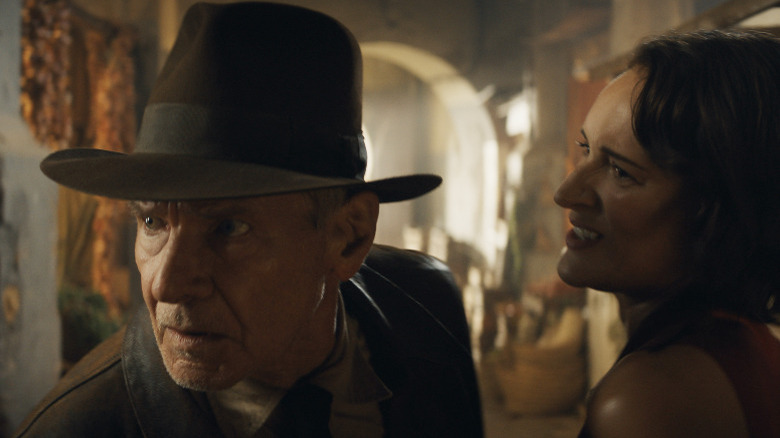
Think of Indy in the classic opening scene of "Raiders of the Lost Ark." It starts with his swaggering walk-off with the idol, where he doesn't see the bag of sand he so carefully measured fail to match the weight of his prize, and, I think, peaks with the moment he makes the running leap across the chasm as the temple's dead-man-switches slowly-but-ominously eliminate his sole avenue of escape. He doesn't clear the gap, but he gets close enough to grab an exposed root. It seems sturdy enough, so he gives a smug grin as he pulls himself up. That grin flashes to "I'm-gonna-die" terror as the root gives away. That's Solo. That's Indy. That's Ford.
"How to walk on that tightrope is something you see him thinking about all day long," says Mangold. "How to kind of play against the obvious grain in the scene. Also, how to kind of find humor where you might not think there would be humor. These gifts are a hallmark of his work."
On June 30, 2023, we'll delight at the sight of Indy taking up his trusty bullwhip and cheating certain death one last time (because there's no way this franchise would ever pull a "No Time to Die"). Even if it's a modest "Rio Lobo" curtain call, the pleasure will be all ours. Harrison Ford knew when and how to be a movie star better than anyone.
Read this next: Harrison Ford's 15 Most Memorable Movie Quotes
The post Harrison Ford Cut The Movie Acting BS Out Of Indiana Jones and the Dial of Destiny appeared first on /Film.
Deus Ex Community Update Version 2.4.1

Fixed Render List & Custom Logo During Install I accidently borked the render list display in the last release, so fixed that. (Thanks Kezyma!) Also noticed I was accidently using the default logo during install instead of my custom purple one, so fixed that too!
WEVTX Event IDs
Now and again, we see online content that moves the community forward, a step or several steps. One such article appeared on Medium recently, titled Forensic Traces of Exploiting NTDS. This article begins developing the artifact constellations, and walks through forensics analysis of different means of credential theft on an Active Directory server.
We need to see more of these sorts of "how to investigate..." articles that go beyond just saying, "...look at the <data source>...". Articles like this can be very useful because they help other analysts understand how to go about investigating these and similar issues.
The sole shortcoming of this article is that the research was clearly conducted by someone used to looking at forensic artifacts in a list; each artifact is presented individually, isolated from others, rather than as part of an artifact constellation. Analysts who come from a background such as this tend to approach analysis in this way, because this is how they were taught.
Further, about halfway through the article we see a reference to "Event ID 400"; the subsequent images illustrate the event source as being "Kernel-PNP". However, this isn't specified. If you Google for "event ID 400", you find event sources such as Powershell, Microsoft-Windows-TerminalServices-Gateway, Performance Diagnostics, Veritas Enterprise Vault, and that's just on the first page.
About a third of the way down the article (sorry, images are numbered for reference) there's an image with the caption "Event ID 4688". The important thing that readers need to understand with this image is that these do not appear in the Security Event Log by default. For these events to appear, successful Process Tracking needs to be enabled, and there's an additional step, a Registry modification that needs to be made, in order for full command lines to appear in the event record. This is important for analysts to understand, so that they do not expect the records to be present by default. Also, you can parse the Security Registry hive using the RegRipper auditpol.pl plugin to determine the audit configuration for the system, validating what you should expect to see in the Security Event Log.
When examining the Windows Event Log as a data source during an investigation, what's actually available in the logs is dependent upon the version of Windows, the installed applications, the configuration of the Security Event Log, etc. Don't assume when reading articles such as this online that, while profoundly useful, you're going to see the log entries in the systems you engage with and examine.
Quentin Tarantino Did Endless Takes To Keep An Old-School Condom Trick In Kill Bill

Digital effects have made a lot of advances in the last few decades, but not everyone prefers a computer-generated spectacle. Filmmakers like Quentin Tarantino prefer the grittier, traditional option — even when the practical effect is less practical than CGI. The "Kill Bill" director went to extreme lengths to avoid creating his gore in post. One effect, in particular, cost him hours on set, but his commitment to his creative vision paid off in the end.
"Kill Bill" might be the most violent movie in Tarantino's filmography, which is saying a lot. The film's most unforgettable moments were filled with blood and action, but what makes a fight scene really great is the sum of its parts. The director had a keen eye for details, and even the quick deaths of minor characters were shot to perfection. One such moment took the most takes that Tarantino had ever done on a single shot.
"We were doing it the old-fashioned way, the Chang Cheh way," he explained in an interview with Robert Rodriguez for El Rey Network. "You take a Chinese condom and you fill it full of the phony blood and then the actors just have it in their hand, and so when slices through air slice the sword the actor just squeezes the Chinese condom and the blood explodes and it looks awesome."
In one over-the-shoulder shot during the fight scene between The Crazy 88 and Uma Thurman's "The Bride," Tarantino had the idea to use this condom effect to simulate Thurman slitting an assassin's throat. Unfortunately, he failed to consider the laws of gravity. "After Uma [slits the girl's throat] and she grabs her throat, you're gonna see like the blood go up," Tarantino said, pointing out the blood spatters in the shot. "Every time we did it the blood went down."
The Spirit Of Chang Cheh Kept Tarantino Going
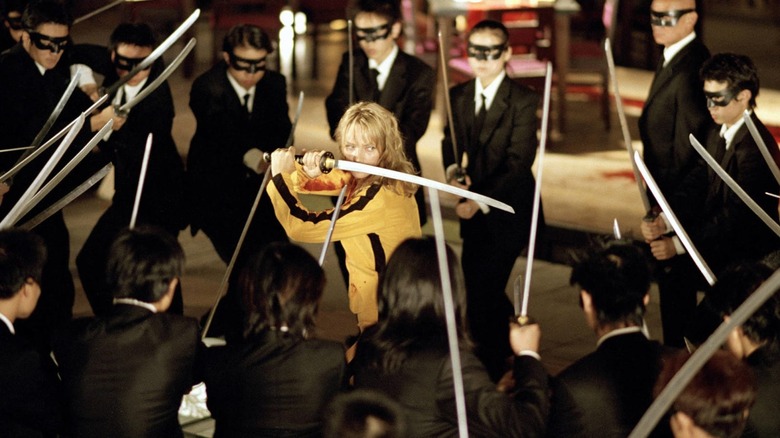
Tarantino was committed to sticking with his old-school condom trick, even when things started to look hopeless on set.
"We kept doing it again and doing it again," the filmmaker recalled. "Take 22, Take 23 — we've changed her clothes three different times. So now she's off for the fourth change and walking by myself. One of those dark moments of the soul," he said. But just when things were looking bleak, the "Pulp Fiction" director caught a second creative wind.
"I swear it was as if Chang Cheh came to me and he said, 'Quentin hang in there,'" Tarantino claimed. "'It's going to happen — it has to happen one way or it. You're due. It's going to go up at some point. You can't quit hang in there. Do it six more times, see what happens.' And then like you know maybe the fifth time or so then it finally did it the right way." All told, that single shot took 34 takes.
Chang Cheh is the late director of the 1970 kung fu movie "Vengeance," which Tarantino has cited as a major influence for "Kill Bill," per Time. The film guided his choice to use practical effects instead of digital ones.
"That s*** looks good, but it looks like a computer did it," he said of CGI in a 2002 interview. "I'd rather have it look good and look like a cool '70s thing."
The Takes Were All Worth It
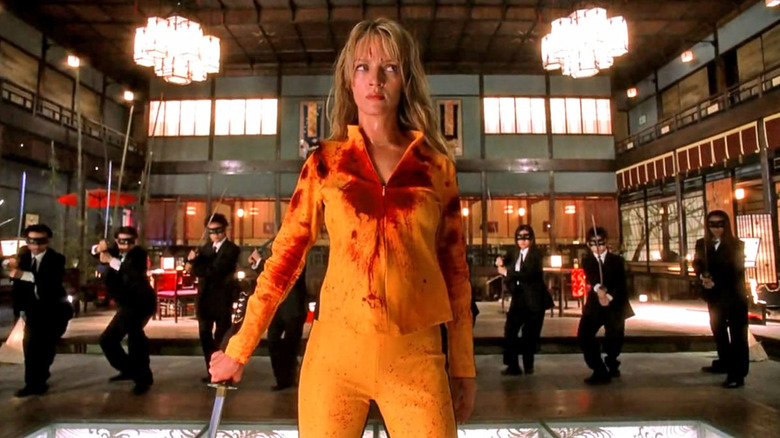
It's no secret that Tarantino prefers a stylistic choice to a realistic one, and his gore is no exception. Even when it comes to blood, the auteur had a very specific vision that harkened back to his primary inspiration for "Kill Bill" — martial arts movies.
"I'm really particular about the blood, so we're using a mixture depending on the scenes," he told Time Magazine. "I say, 'I don't want horror movie blood, all right? I want Samurai blood.' You can't pour this raspberry pancake syrup on a sword and have it look good. You have to have this special kind of blood that you only see in Samurai movies."
Tarantino's perfectionism might cost him a lot of time on set, but it's ultimately why he's been able to maintain such a consistent and distinct style in all of his work. Every shot, no matter how fleeting, is an opportunity to innovate. Tarantino didn't miss a single opportunity to be creative, and he wasn't afraid to be bold — as long as he used protection.
Read this next: 13 Tarantino Projects We Never Saw But Wish We Could've
The post Quentin Tarantino Did Endless Takes To Keep An Old-School Condom Trick In Kill Bill appeared first on /Film.
Microsoft Outlook Users Flooded With Spam After Filters Break
Numerous Microsoft Outlook users have reported floods of spam in their inboxes after the provider's spam filters allegedly stopped working. Microsoft is yet to confirm or deny this fault.
MyloBot Botnet Spreading Rapidly Worldwide: Infecting Over 50,000 Devices Daily
The Microservice Migration
"Why aren't we using microservices?"
It was an odd way to start a meeting, but it got Mr. TA's attention. TA was contracting with a client, and sitting in a meeting with their senior architects. TA and one of his peers exchanged a glance and a small eye-roll. They knew exactly what had happened: Alvin, the senior architect, had learned about a new fad.
The application that TA's team was working on, and the core product which the client offered, was a pretty simple data-driven application. It was, at its core, one SQL Server database, a simple front-end, and could easily run reliably off of a moderately powerful server. With co-location and rackspace costs, it could cost them a few thousand a month to operate.
But the senior engineers heard about the cloud. And they wanted everything in the cloud. And they wanted all the latest features that Azure had to offer. Which meant they were spending hundreds of thousands a month to host the application.
"It doesn't matter why we aren't using microservices," the senior architect went on. "What matters is that we're getting left behind. If we want to operate at webscale and provide maximum advantage to our users, with always-on reliability, we need to be using microservices. And don't worry: I have a plan for the transition."
Alvin pulled up a PowerPoint slide entitled "Initech's Microservice Migration".
Alvin's microservice plan called for dividing the application up into 13 modules. The boundaries were arbitrary, with only the vaguest sense of putting common functionality into the same microservice. Most of the proposed microservices weren't single purpose- they each contained multiple unrelated pieces of functionality, making them not exactly micro.
But that wasn't the biggest issue. Alvin had a vision of 13 different microservices, and each microservice needed to have its own database. After all, each microservice was supposed to be independently deployable from any other. So their single SQL Server database got split into 13 different databases.
Of course, this created all sorts of new problems. The "Admin" "micro"service (which contained a few hundred endpoints, once again, stretching the definition of "micro") had all the admin tables siloed off into its own database. But every other "micro"service needed to access the data in those admin tables.
Now, if this all stayed in one database, it'd be easy to do joins. Heck, even if this were just an on-prem SQL Server deployment, cross-database queries are completely doable. But in Azure, your only option is to use the "Linked Tables" feature, which means creating an object for each remote table you want to access. Since you have 13 databases, all needing several tables from every other, you can see how this quickly spirals out of control in terms of complexity.
"But that's not a problem," Alvin explained, when TA pointed out this problem. "We're using microservices, which means we scale horizontally."
"What do you mean by that?"
"We just add more resources to the cloud, and let our microservices collaborate," Alvin said.
"I'm not clear how that solves the problem."
"That's why I'm the architect."
It took several weeks of back-and-forth to get Alvin to explain his brillant architecture. What Alvin intended was to have every microservice fetch the related data by talking to other microservices. All the joins would just be done in the application layer, and any performance problems could be solved by going "webscale", which is to say: throwing money into a pit and setting it on fire to please the great god Azure.
Despite Mr. TA's protests, that was the direction everyone marched off in. When it rapidly became clear that this was non-viable, Alvin adapted.
"So, to boost performance, we'll replicate a few tables between databases."
Replication was an initial bulk copy, and then updating the "micro"service responsible for those tables to do its update multiple times in multiple databases. Unfortunately, due to the mess Alvin had made of things, the databases had lost referential integrity, which meant they couldn't leverage foreign key constraints to protect the data.
The worst "replicated" table was the one for tracking shipments. In the original, "source of truth" location, it was designed with a slew of NVARCHAR columns named UserDefinedField01, and UserDefinedField27 and UserDefinedField112. There was an additional lookup table that applications could use to map those fields to UI elements, but that didn't exactly help all the other "micro"services that wanted that data. So Alvin set up a replication process that normalized that data into a more traditional database schema in the other 12 databases that wanted the data. Unfortunately, it wasn't the same normalization of the data in each of those remote databases, making the maintenance of replication a gigantic pain.
At this point, it should surprise no one to learn that Alvin also just used NVARCHAR fields for basically everything, even things that absolutely have no reason to be. For example, the Users table, quite reasonably, had an autonumbered UserId field. It also had a UserName field. Every table that related (or "related", in the databases that didn't contain user information), used UserName as the foreign key.
Eventually, Alvin's microservice migration limped across the arbitrarily defined finish line. Alvin presented management with a self-congratulatory project retrospective that highlighted his leadership, his technical vision, and how their were now well positioned for the future, by using the latest techniques.
Interestingly, this retrospective completely ignored the costs of the migration, or the fact that to maintain the same level of performance as the old architecture, they had to spent almost 75% more on cloud services.
Internet Archive Joins Library Groups at the Supreme Court
On February 23, 2023, the United States Supreme Court will hear oral arguments in Gonzalez v. Google. The case is, in a narrow sense, about whether certain algorithmic recommendations of a very large online platform can give rise to civil liability. But the Court’s ruling could fundamentally “reshape the internet”, redefining the circumstances in which a wide variety of websites and online services–including libraries–could be liable for the actions of their users. Internet Archive was proud to join the American Library Association, the Association of Research Libraries, the Freedom to Read Foundation, and the Electronic Frontier Foundation, in a “friend of the Court” brief urging robust Section 230 protections for libraries and others.
As the Association of Research Libraries has previously noted, “libraries are included in” the protections of Section 230, and “[a]ny changes to the liability protections of 230 may endanger the ability of libraries to fulfill their public service missions.” Following from this, our brief highlights a number of important library projects and services “designed to share and build knowledge” which are currently protected by Section 230; these could be threatened by sweeping changes to the law. In fact, providing a space for the maintenance and development of these kinds of projects is exactly what the framers of Section 230 set out to do: it was enacted “to promote the continued development of the Internet” and so that it could continue to provide “a forum for a true diversity of political discourse, unique opportunities for cultural development, and myriad avenues for intellectual activity.”
As the brief explains, substantial changes to Section 230 could frustrate these purposes by making it harder for libraries to use the internet to broaden and deepen the public’s access to knowledge (among other things). And while it is impossible to know exactly how Section 230 might be changed by the Court, and how those changes could impact the behavior of libraries and others who rely on Section 230 today, the brief highlights a number of concerning scenarios that we hope the Court will consider. These kinds of concerns have been raised by many, including Professor Eric Goldman, who has explained how changes to the law occasioned by this case could make it too costly or burdensome for many online services to operate the way they do today; this could result in an internet dominated by “a small number of voices” promoted by the largest corporations and hidden behind paywalls.
At the Internet Archive, despite the challenges, we continue to believe in the power of the internet to democratize and expand access to knowledge. As EFF said when it filed the brief, “[a]s the internet has grown, its problems have grown, too,” but we can “address those problems without weakening a law” that has provided meaningful protection to everyone, including libraries. As courts and legislatures consider changes to this existing legal structure, we hope they keep in mind the public’s interest, so we can work towards an internet that preserves public interest spaces and is shaped by public interest values.
The post Internet Archive Joins Library Groups at the Supreme Court appeared first on Internet Archive Blogs.
"It may sound like an insensitive statement, but the cold hard truth is that there are a lot of stupid people in the world, and their stupidity presents a constant danger to others" [Obvious]
Enterprise Blind Spots and Obsolete Tools – Security Teams Must Evolve
The conventional tools we rely on to defend corporate networks are creating gaps in network visibility and in our capabilities to secure them.
The post Enterprise Blind Spots and Obsolete Tools – Security Teams Must Evolve appeared first on SecurityWeek.
Ant-Man 3 Introduces The MCU's New (And Weirdest) Avengers Team Member
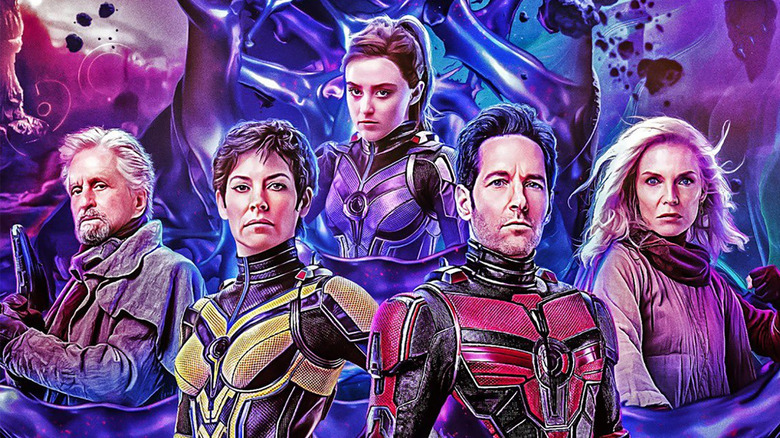
This post contains major spoilers for "Ant-Man and the Wasp: Quantumania." Please proceed with caution.
Whenever a new film or show from the Marvel Cinematic Universe drops, True Believers are excited to meet the newest heroes in line to join the ranks of Earth's Mightiest Heroes. After all, since the events of "Avengers: Endgame," there's certainly room on the roster for some new additions due to a few key vacancies. Though they haven't properly assembled just yet, the House of Ideas has introduced Shang-Chi, America Chavez, Ironheart, Moon Knight, Ms. Marvel, and She-Hulk in the Multiverse Saga so far, among others.
Now, with the release of "Ant-Man and the Wasp: Quantumania," Phase Five (and beyond) is in full effect and ready to follow suit by adding more gallant do-gooders to the MCU mix. The new film from Peyton Reed already touts a full roster of valiant individuals, including Scott Lang, Janet Van Dyne, Dr. Hank Pym, and Hope Van Dyne. So who is the latest character to make the jump from the page to the screen to join their ranks and wave the Avengers flag into battle? Considering the theme of family in the movie, there's clearly only one option.
Cassie Lang? I mean, yeah, she's in the film and she comes into her own as costumed superhero with the help of her father and the Pym-Van Dyne family, but that's not who we're talking about. No, the answer is in fact MODOK.
Criss Crossed
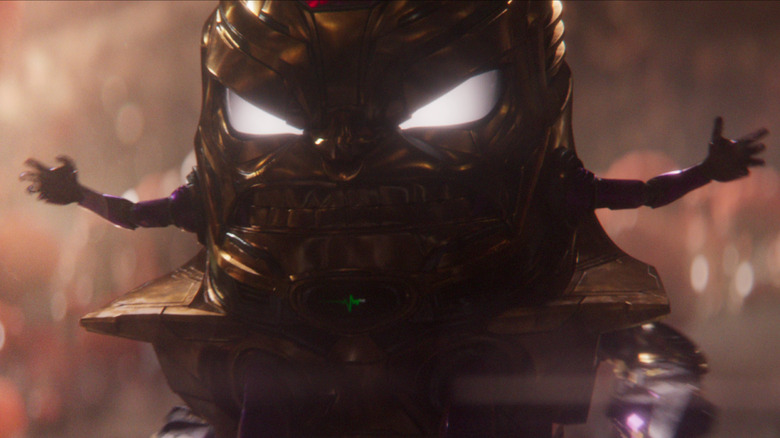
Just like in the pages of Marvel Comics, the Mechanized Organism Designed Only for Killing is a ruthless villain in the MCU. However, a few details have changed in this adaptation. Despite that, Reed and company still managed to nail the right vibe for the character. Instead of George Tarleton, the scientist who became MODOK after experimenting on himself, this version is Darren Cross.
First introduced in the 2015 film "Ant-Man," the villain played by Corey Stoll was the former protege of Dr. Pym. But when the former S.H.I.E.L.D. operative refused to share his Pym Particle research with his mentee, Cross set out to replicate the work himself in order to create the ultimate weapon. The "son that Hank never had" started his journey by usurping Pym's company out from under him and using the resources to create the Yellowjacket, a suit with similar capabilities to Hank's Ant-Man technology. However, the knockoff particles created by Cross were affecting his mind and slowly driving him mad. In the end, Scott Lang defeated Yellowjacket and banished him to the Quantum Realm.
As we find out in "Quantumania," the fall into the microverse left Cross horribly disfigured. He now possesses an oversized head with a tiny body and short limbs, as well as an overwhelming need for revenge. That's when he was discovered by Jonathan Majors' Kang the Conqueror, who offered the thwarted rogue futuristic armor that also doubles as a mechanized hover chair to assist the newly dubbed MODOK get around. From that point onward, he served as Kang's primary henchman in the Quantum Realm... Until he came face to face with Lang and Pym once again.
All In The Family
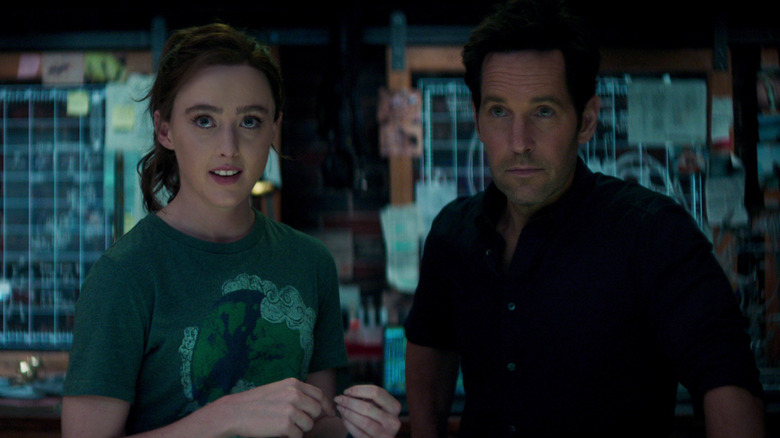
When they are sucked into the Quantum Realm, Scott and Cassie are taken prisoner by Kang and MODOK. During this period, we uncover the struggles that Cross has endured since their last encounter. But after hearing about his hardships, the father and daughter try to convince MODOK that things don't have to be that way. More specifically, the younger Lang shares Cross, "It's never too late to not be a dick." Really taking those words to heart, Cross aids Ant-Man, the Wasp, and their family in their fight against Kang. Unfortunately, that's when the troubled being meets his demise. But before he dies, MODOK shares that he always looked at Scott like a brother, prompting a bit of an awkward reaction. He was also glad to spend his final moments fighting for good like Captain America, Iron Man, and Black Widow before him. "At least I died an Avenger," he said before passing away.
These heartfelt moments were played up as jokes, because they were definitely delusions caused by Cross' self-manipulation from his experiments and Kang's own corruption. But rather than rain on his parade, Paul Rudd's titular hero let all that slide in favor of a tender moment for a reformed man that did some good on his way out of his life.
Ultimately, Kang the Conqueror was defeated. Before Ant-Man and the rest of the gang have to contend with the Council of Kangs, they have time to savor in this victory and honor the hero of the hour, MODOK. He definitely wasn't the Avenger that we were expecting to save the day, but he was... definitely there when it happened. It's just a shame that he won't be there to assemble when the team needs him next time. Although, it's a big multiverse out there, so never say never.
Read this next: The Most Powerful MCU Villains Ranked
The post Ant-Man 3 Introduces the MCU's New (and Weirdest) Avengers Team Member appeared first on /Film.
Microsoft Defender for Office 365 named Best Email Security Service of 2023 by SE Labs
Microsoft Defender for Office 365 receives Best Email Security Service of 2023 award by SE Labs.
The post Microsoft Defender for Office 365 named Best Email Security Service of 2023 by SE Labs appeared first on Microsoft Security Blog.
You Shouldn’t Use Your Phone Number for Two-Factor Authentication, Anyway

You should be using two-factor authentication (2FA) with each and every one of your accounts that allows it. You probably already do for at least some accounts, and it probably pisses you off from time to time. Every time you try to log in, you need to find your phone, check the code they texted you, and enter it to…
The Climactic Brawl In Enter The Dragon Is The Best Action Scene Ever
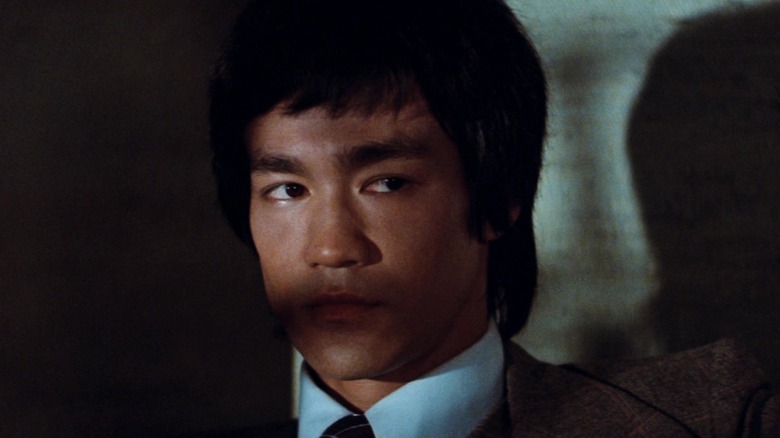
(Welcome to Best Action Scene Ever, a column dedicated to breaking down the best, most effective action sequences throughout the genre. In this edition, we're breaking down the go-for-broke climax of "Enter the Dragon.")
So far, we've kept the focus of this column on the relatively recent past to highlight some of the most groundbreaking, visually inventive action sequences that filmmakers have innovated — thanks in large part, no doubt, to the wealth of inspirations throughout the decades that they were able to pull from. But what about the classics that practically invented the playbook in the first place? In this week's edition, we're taking things back to the '70s to give credit where it's due and pay homage to arguably the most influential martial arts movie of them all.
1973's "Enter the Dragon," directed by Robert Clouse, earned its reputation for many different reasons: from representing American audiences' first real introduction to the legendary Bruce Lee, to inspiring a whole swath of genre imitators, to the bittersweet fact that this would be Lee's final completed work before his untimely death. But more than anything else, its impeccably choreographed action and genuinely inspired premise — an amusingly James Bond-like villain holding a martial arts tournament on a remote island as a cover for recruiting members into his criminal empire — make it stand out and hold up today. No sequence better sums up the appeal of this incredibly successful box office hit than the final brawl that sees Lee take on an entire army of henchmen before dispatching the villain in one of the most challenging filming environments ever.
The Scene
Sent to infiltrate the villainous Han (Kien Shih), both a nefarious drug lord and a disgraced former student of their Shaolin Temple, Mr. Lee's (Bruce Lee) luck finally runs out when he's captured after a lengthy series of fights and paraded out in front of Han's men for all to see. When he and another captive Roper (John Saxon) are commanded to fight each other to the death but refuse, leading to Roper's defeat of the imposing mini-boss Bolo (Bolo Yeung, who's built like Tom Hardy's Bane in "The Dark Knight Rises"), all hell breaks loose as Han sends in all of his minions to take out the dual threats once and for all.
What follows is a brilliantly staged exercise in organized chaos. Dozens upon dozens of stuntmen fill every inch of the screen, threatening to overwhelm our senses and cause us to lose track of Bruce Lee amid all the mayhem. Instead, we're treated to some of the absolute best moments the film has to offer, punctuated by Lee's primal yells, numerous zoom-ins to capture the martial arts legend's expressive face, and one of the most thrilling repudiations of the idea that "Less is more." This sequence is where restraint comes to die, along with hordes of henchmen who have the unfortunate luck to cross paths with a fully unleashed Lee.
It all crescendos when Han himself enters the melee, pulling from his bag of tricks and strapping on a claw hand to give him a leg up over our unstoppable — though never invulnerable — hero. That seemingly minor aspect, however, proves to be the reason why so much of this climactic scene works so well.
Why It Works
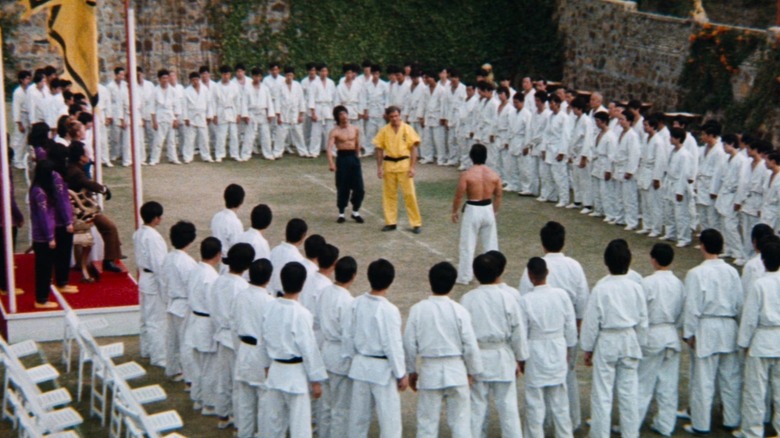
Would it be too much of a copout to state that it all works simply because Bruce Lee in his prime was an absolute force of nature? While the choreography, staging, and the startling clarity of all the action all deserve due credit for the scene's effectiveness, viewers can't go far without acknowledging the sheer charisma and commitment on display by the action hero. The barely-contained sparkle in his eye as he lines up his next victim and that slight smile on his face after pulling off a successful chain of fight moves all help immortalize the performer as a true-blue movie star — but it's the fact that he isn't afraid to take a punch and shatter that illusion that truly puts this sequence over the top.
As much as he establishes himself as a one-man wrecking machine, Lee takes more than his fair share of damage along the way. Reminiscent of Keanu Reeves getting put through the wringer in each "John Wick" movie, Lee is never efficient enough to avoid injury altogether. That comes in stark relief when the one-handed Han finally has it up to here and enters the fray himself, armed with his makeshift claw weapon on one arm and focused entirely on taking our hero down. When Han quickly manages to land a blow on his opponent's face, Lee takes a beat to incredulously feel the blood on his face before launching into an even more frenzied attack.
Bereft of his weapon, Han uses the chaos to escape with Lee hot on his heels. Not coincidentally, this is the moment where "Enter the Dragon" enters all-timer territory.
The Key Moment
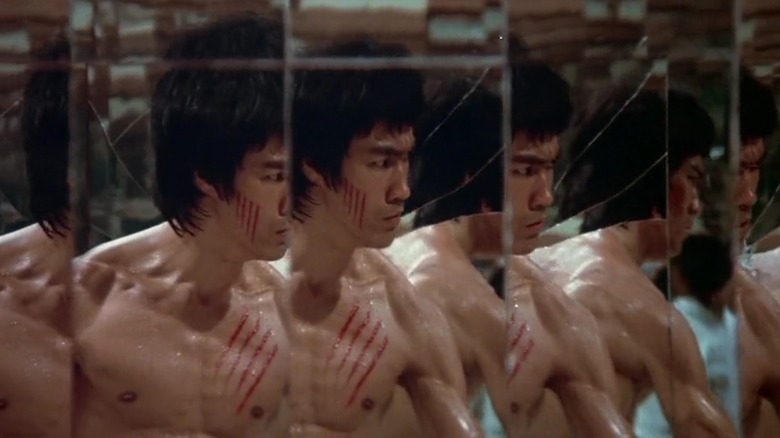
Crucially, everything slows down once Han and Lee face off once again within the villain's compound, the former now armed with Wolverine-like iron razors. The raucous noise and clamor of the previous moments are replaced with a deadly calm as the two size each other up, leading to a brutal hand-to-hand fight that leaves both combatants with plenty of damage. But just as our hero seems to take the upper hand, Han escapes into an inner room covered with countless mirrors. In yet another sequence that switches up the rules of engagement decisively, Lee is put on his back foot for a change as brute force is no longer enough to win the day.
The claustrophobic hall of mirrors set piece might remind younger viewers of similar moments in, say, "John Wick: Chapter Two" (which, yes, "Enter the Dragon" was invoked as a source of inspiration), but the early establishment of a "No guns" policy on Han's island sets the stakes even higher than most modern action movies. No random bullet fired from a distance will mark the end of either fighter; only a close-up and painfully intimate encounter at the end of each other's fists will do the trick.
The fraught scene derives as much tension out of the disorienting display of mirrors as it possibly can, leading Lee on a cat-and-mouse chase in plain sight to pull one over on Han before he can do the same to him. Again, Lee's vulnerability sells us on the dangers of the scene, even if we intuitively know the hero will come out on top no matter what. Lee does exactly that, forcing Han into the open and finishing him off with a well-placed kick impaling him on his own spear.
Action would never be the same again.
Read this next: 17 '80s Action Movies You Definitely Need To See
The post The Climactic Brawl In Enter The Dragon Is The Best Action Scene Ever appeared first on /Film.
Your Guide to Getting a Car Unstuck in the Snow

A car is a great thing to have when you live somewhere cold and snowy: You are toasty and warm inside the vehicle and only need to face the elements for a few minutes after parking. As someone who left her car, but not the snow, behind when moving cross-country, I really miss the luxury. What I don’t miss is having to…
Microsoft to Bring All Its Xbox PC Games to GeForce NOW, Including Activision Blizzard’s If the Deal Passes

[UPDATE] The press release is now available, adding some details to the announcement.
Microsoft and NVIDIA are reportedly working to integrate Xbox PC games into GeForce NOW as soon as possible, whether purchased via the Microsoft Store, Steam, or the Epic Games Store.
Microsoft Gaming CEO Phil Spencer said in a statement:
Xbox remains committed to giving people more choice and finding ways to expand how people play. This partnership will help grow NVIDIA’s catalog of titles to include games like Call of Duty, while giving developers more ways to offer streaming games. We are excited to offer gamers more ways to play the games they love.
Jeff Fisher, senior VP for GeForce at NVIDIA, added:
Combining the incredibly rich catalog of Xbox first party games with GeForce NOW’s high-performance streaming capabilities will propel cloud gaming into a mainstream offering that appeals to gamers at all levels of interest and experience. Through this partnership, more of the world’s most popular titles will now be available from the cloud with just a click, playable by millions more gamers.
[ORIGINAL STORY] At a press conference organized this afternoon in Brussels, Belgium, Microsoft president Brad Smith revealed (via Tom Warren) that all Xbox games available on the PC platform will be added to the GeForce NOW library as part of an agreement with NVIDIA.
You'll recall that NVIDIA recently relayed some concerns to the US Federal Trade Commission regarding the $68.7 acquisition of Activision Blizzard. At the time, NVIDIA stressed the need to for 'equal and open access to all games'. The GeForce company is now supportive of the deal. Crucially, Smith said the same would extend to Activision Blizzard's games if the $68.7 billion passes the regulatory hurdles. This would be a net win for NVIDIA as it never had Microsoft's Xbox games on GeForce NOW, while Activision Blizzard's games were removed from GFN once the service launched out of beta in early 2020.
Cloud gaming concerns were at the core of the objections made by the FTC and the UK's Competition and Markets Authority (CMA) against the deal's completion. The FTC actually sued to block the deal, while the CMA has provisionally found that Microsoft acquiring Activision Blizzard would harm competition. The European Union's regulatory body didn't release a final statement yet, but it is known to be similarly concerned.
Microsoft is trying to assuage those concerns with a series of deals and maneuvers. Earlier today, we learned of a binding 10-year agreement with Nintendo to bring Call of Duty to Nintendo platforms if the deal goes through. During the aforementioned press conference, Brad Smith sent a comment to Sony (again, via Tom Warren):
Sony can spend all of its energy trying to block this deal, or it can sit down with us and hammer out an agreement that addresses what it says it's concerned about, mainly the access to Call of Duty in the future.
Microsoft offered the same 10-year agreement to bring Call of Duty to PlayStation platforms with full parity of content and features. Still, Sony has refused so far. Per Jez Corden's tweet, who is also at the conference, the documents are ready if Sony wants to sign that deal. Smith also said that one of the potential structural remedies suggested by the CMA, selling Call of Duty to another company, is neither reasonable nor realistic.
The post Microsoft to Bring All Its Xbox PC Games to GeForce NOW, Including Activision Blizzard’s If the Deal Passes by Alessio Palumbo appeared first on Wccftech.






